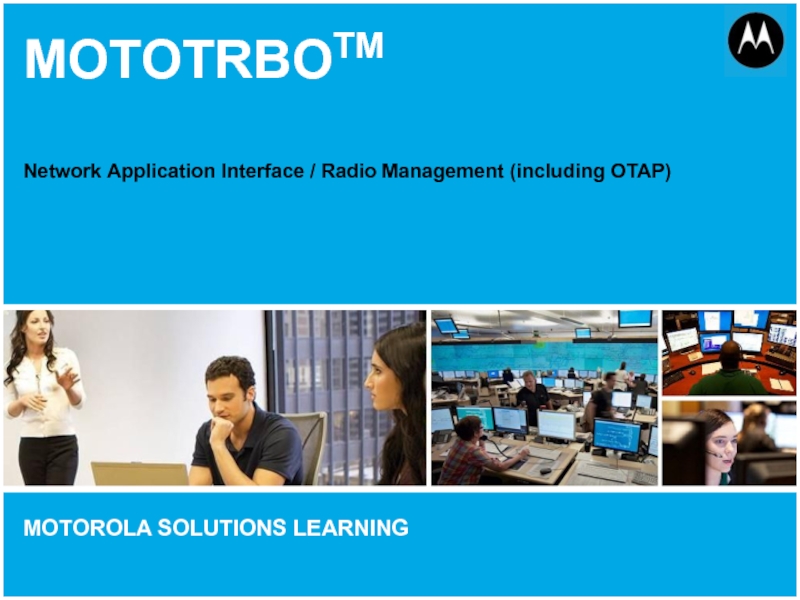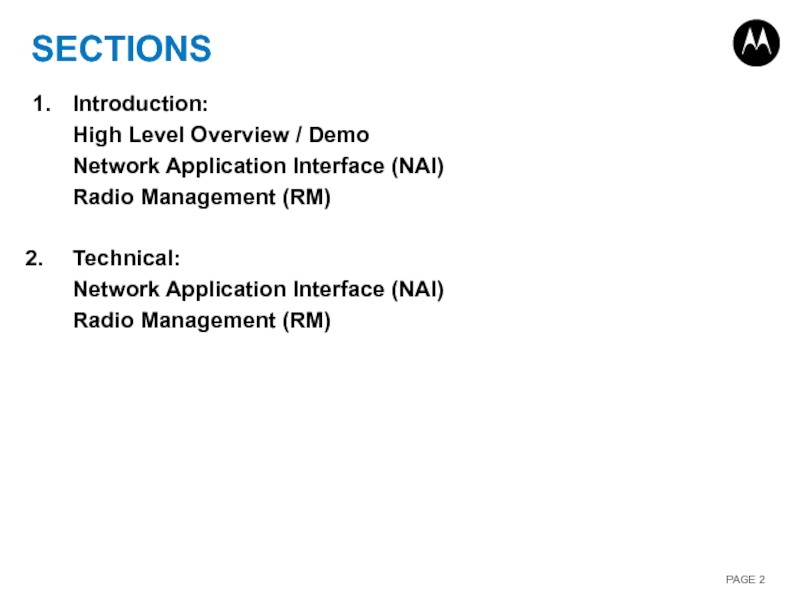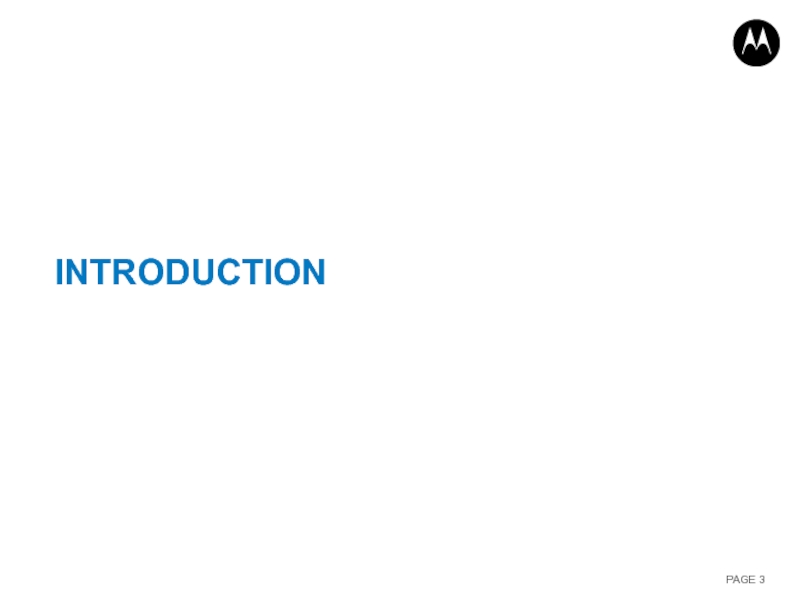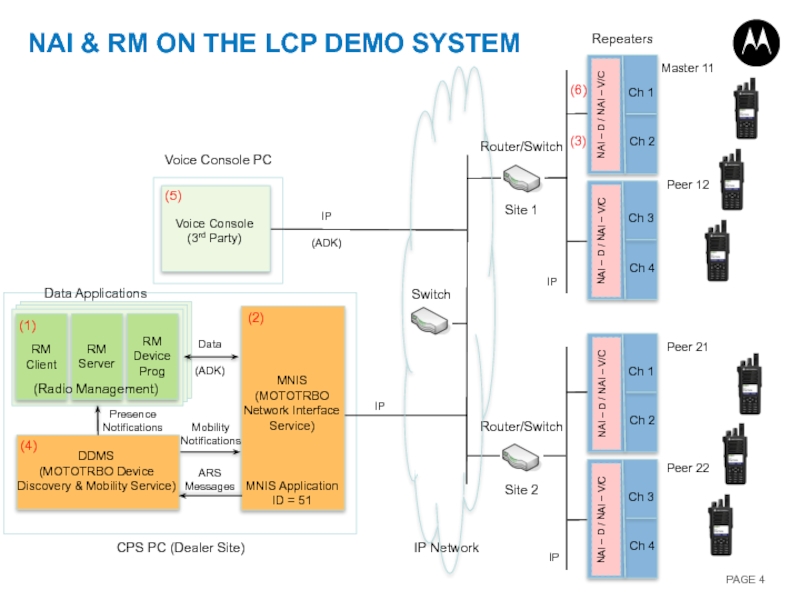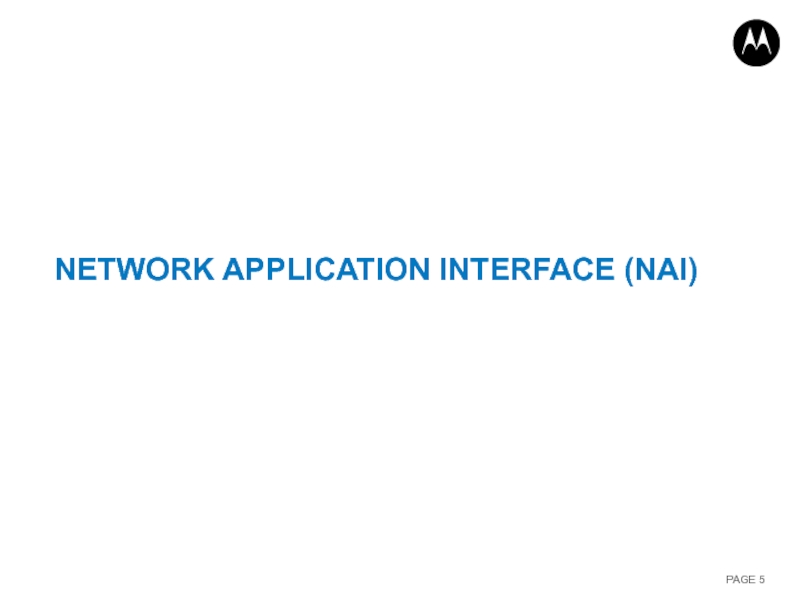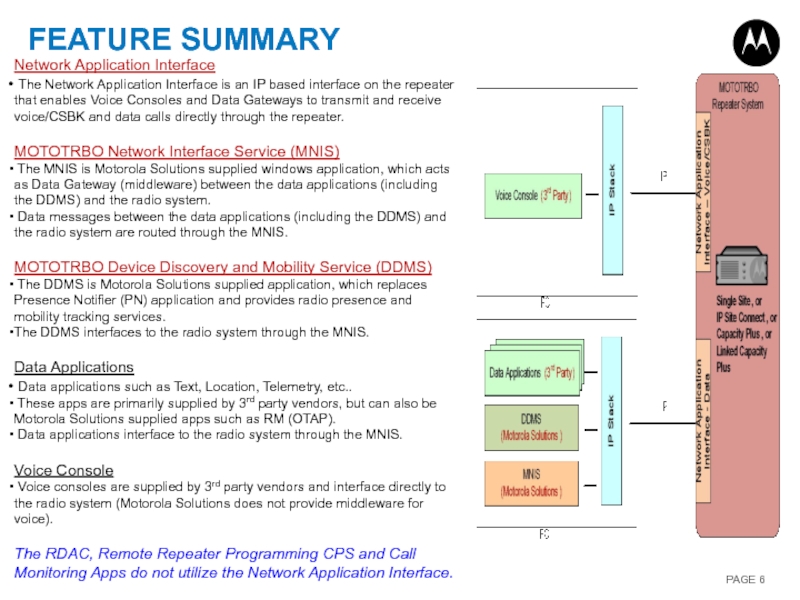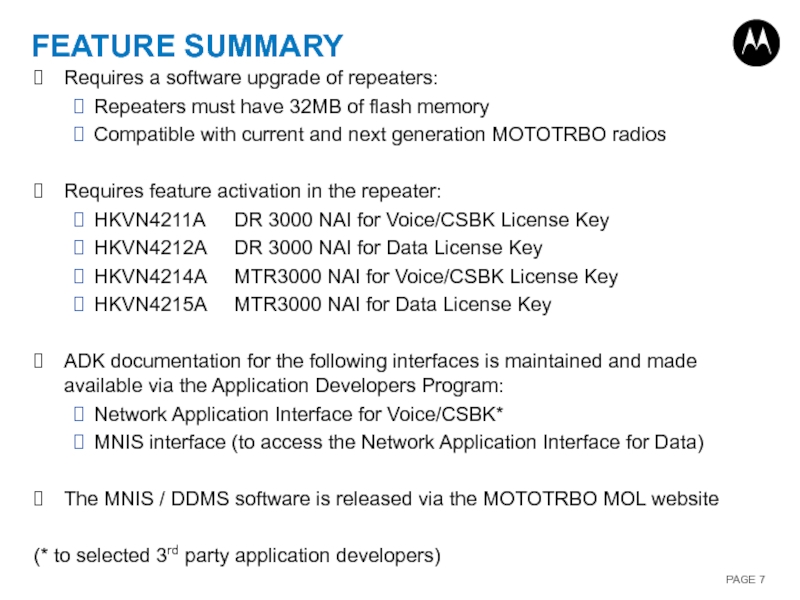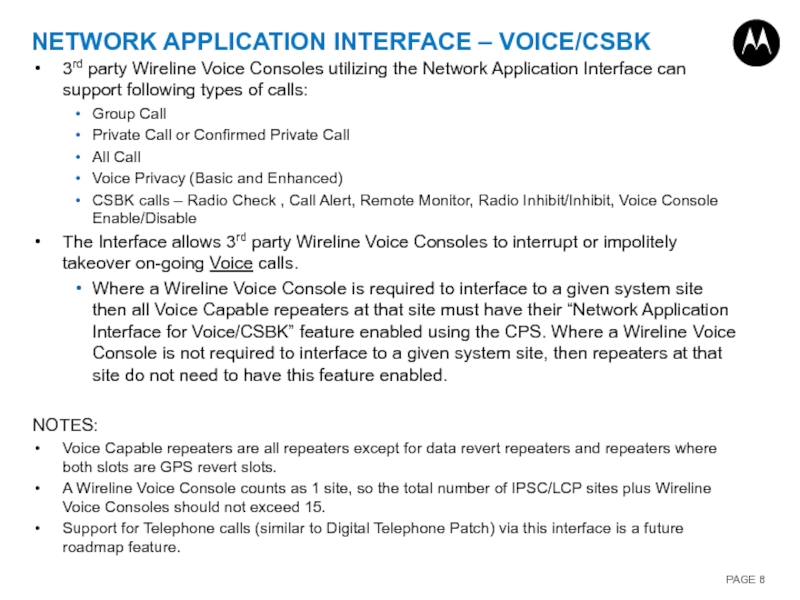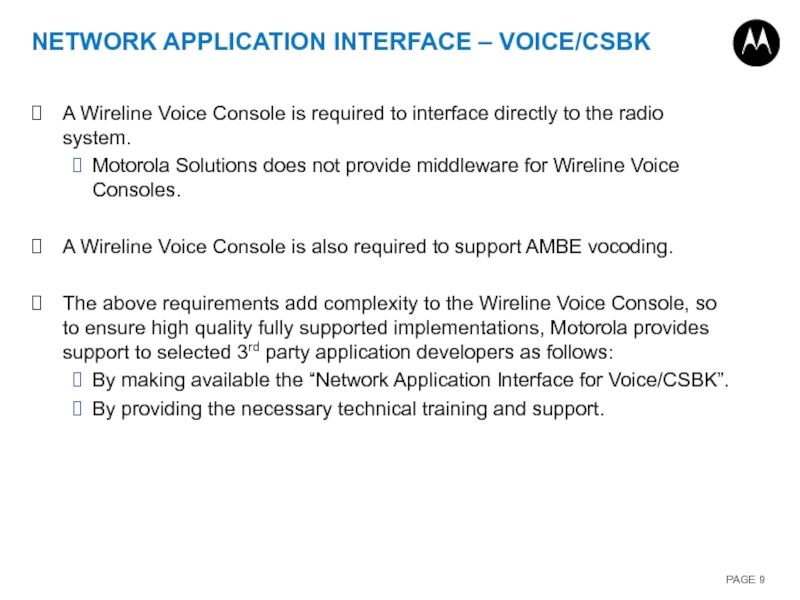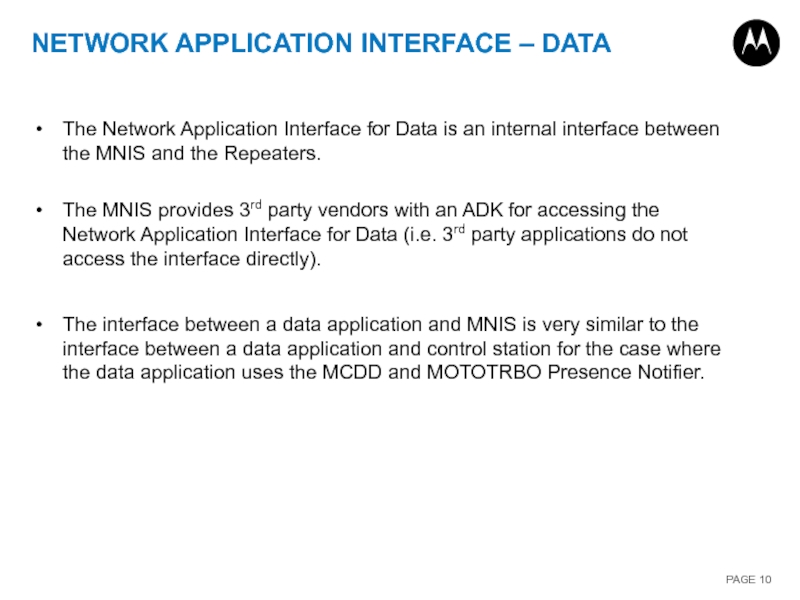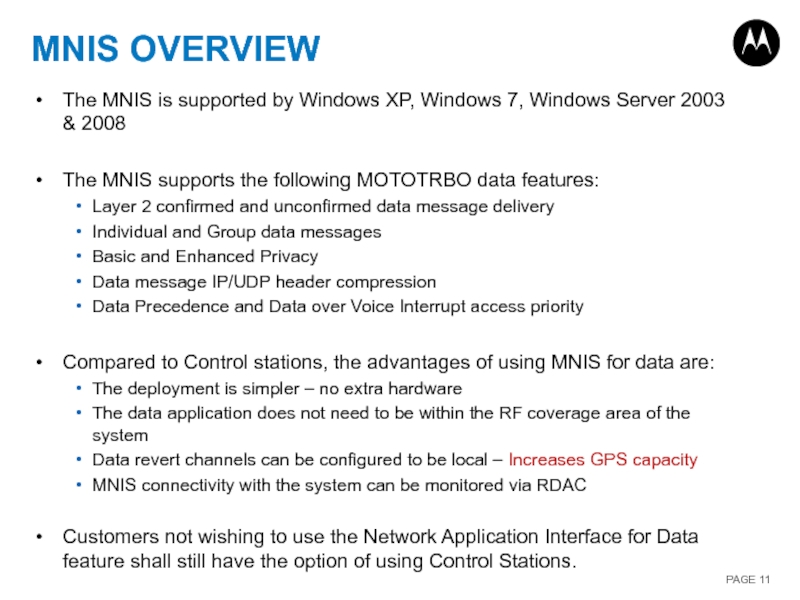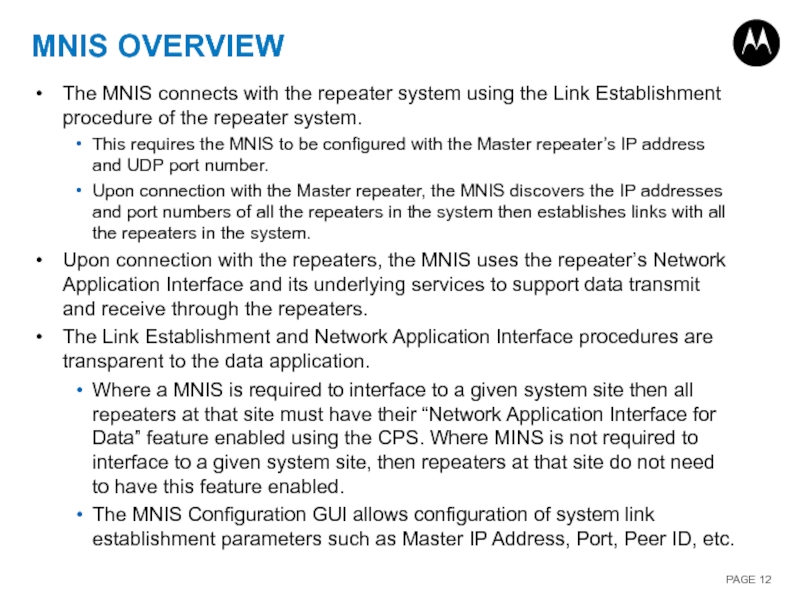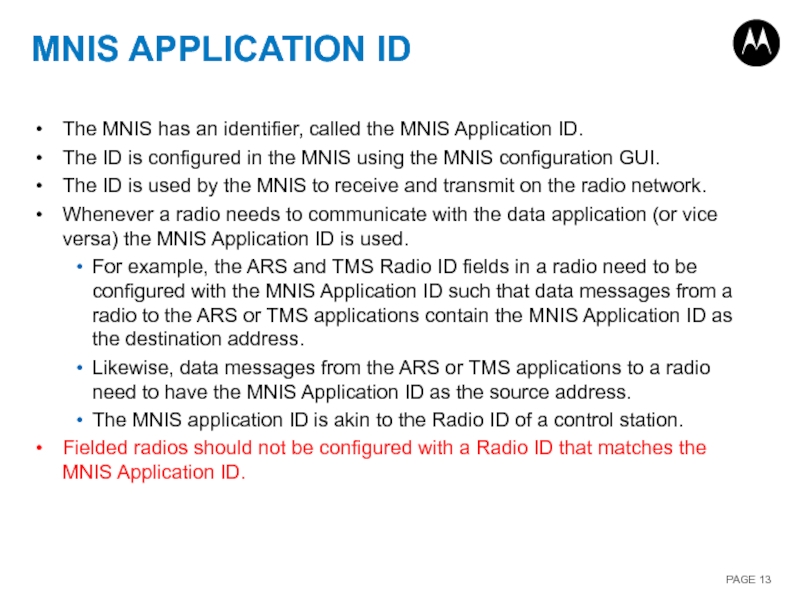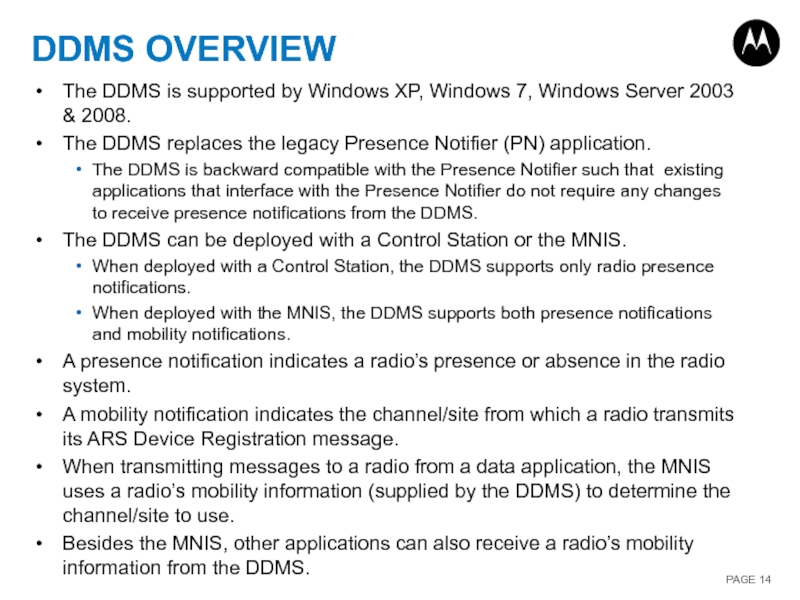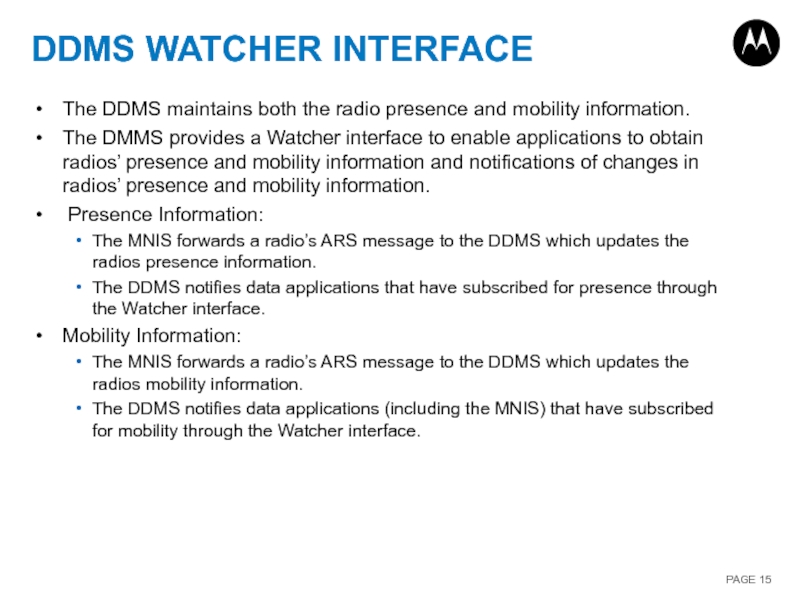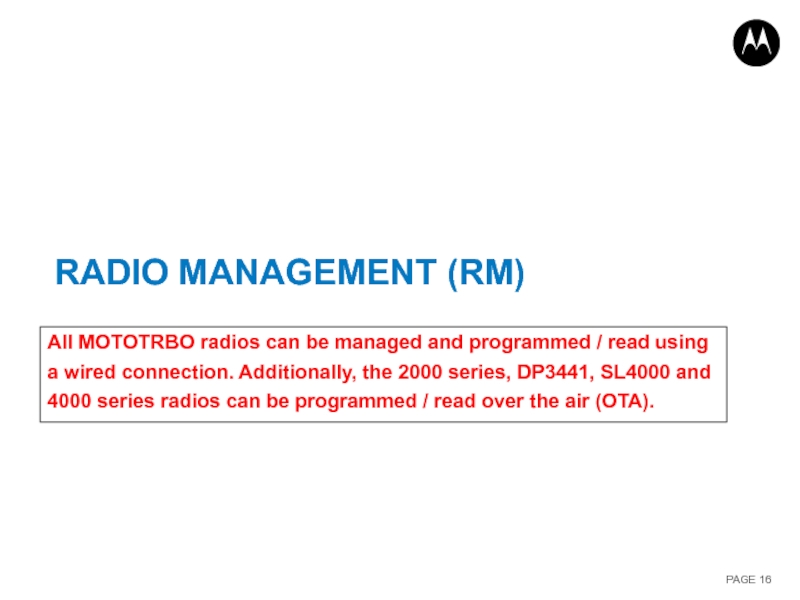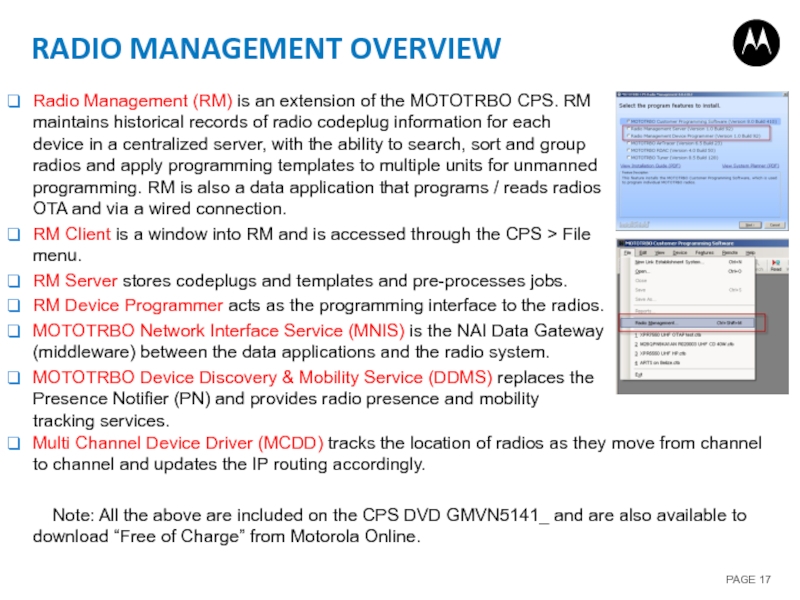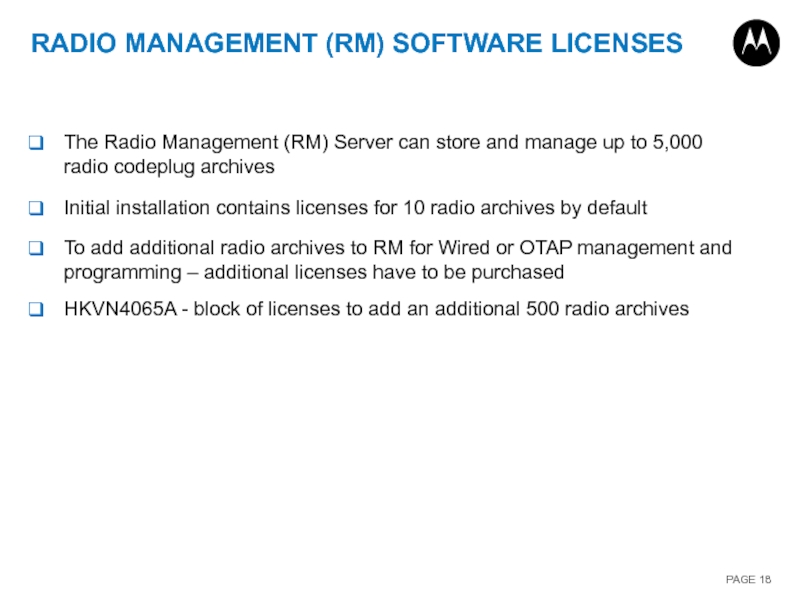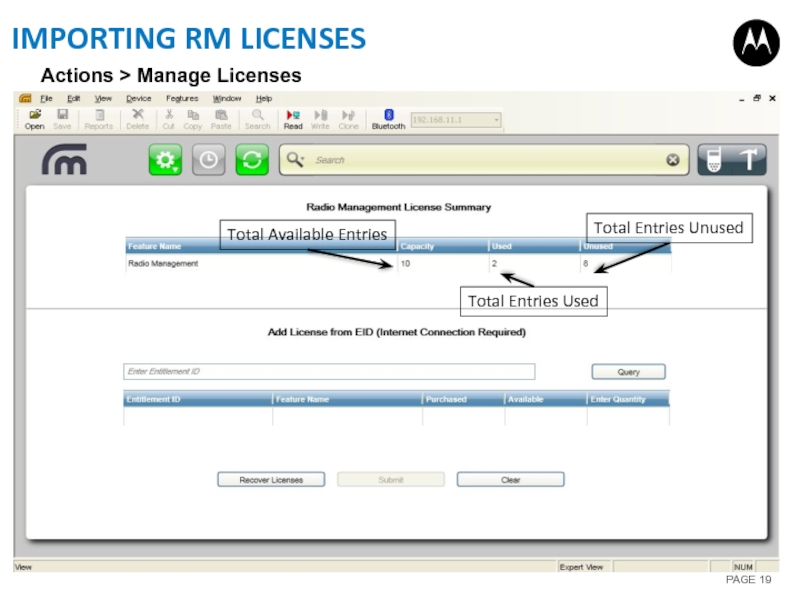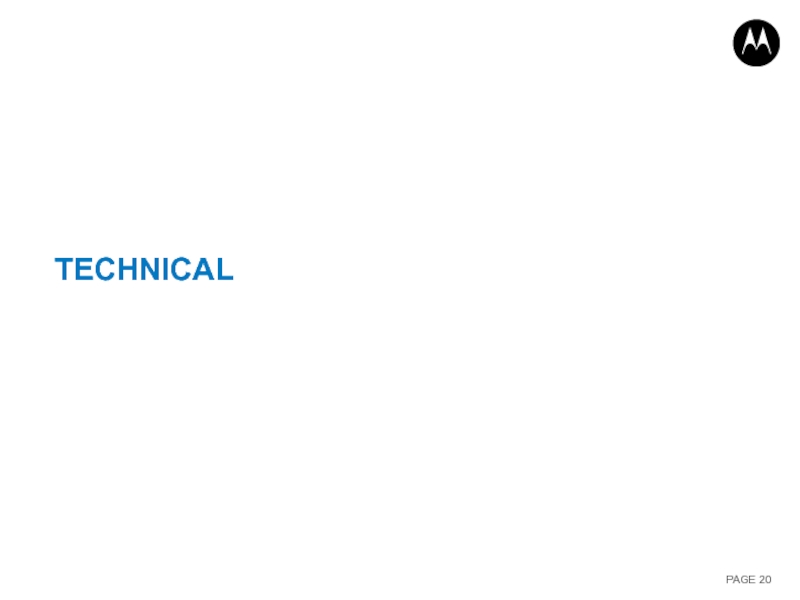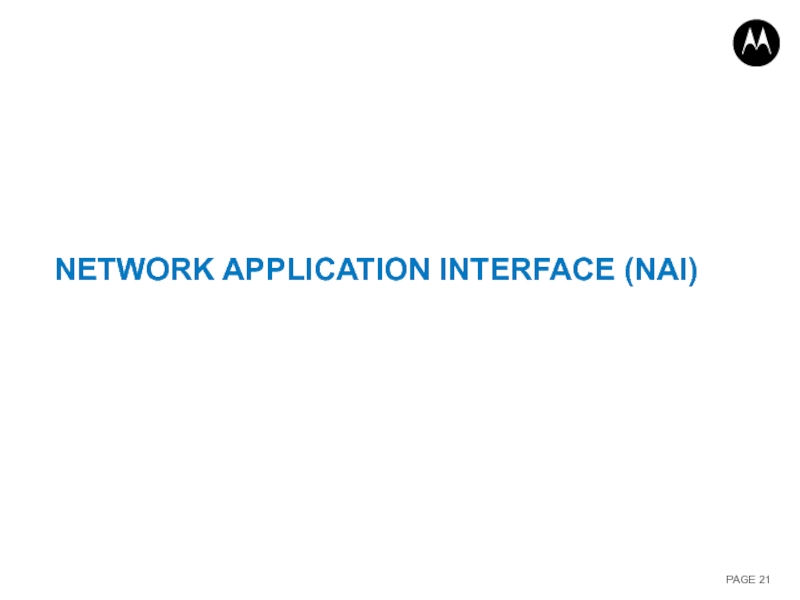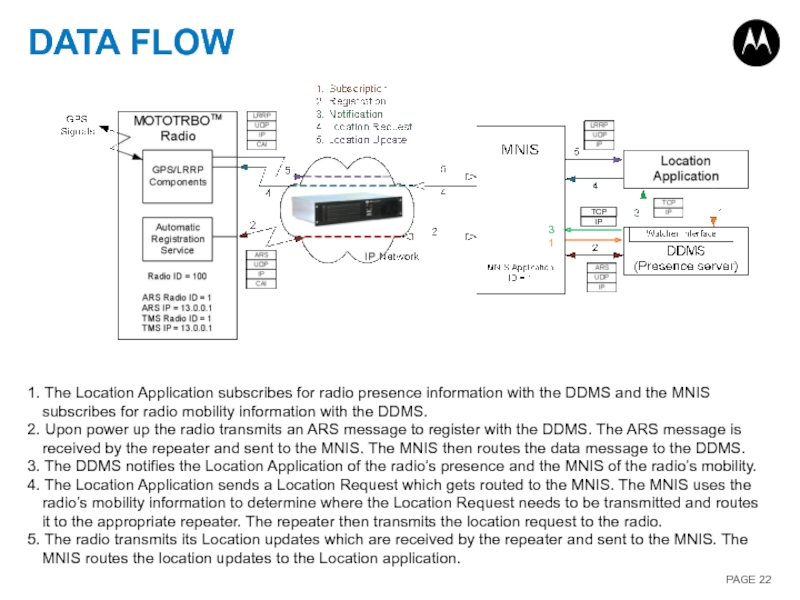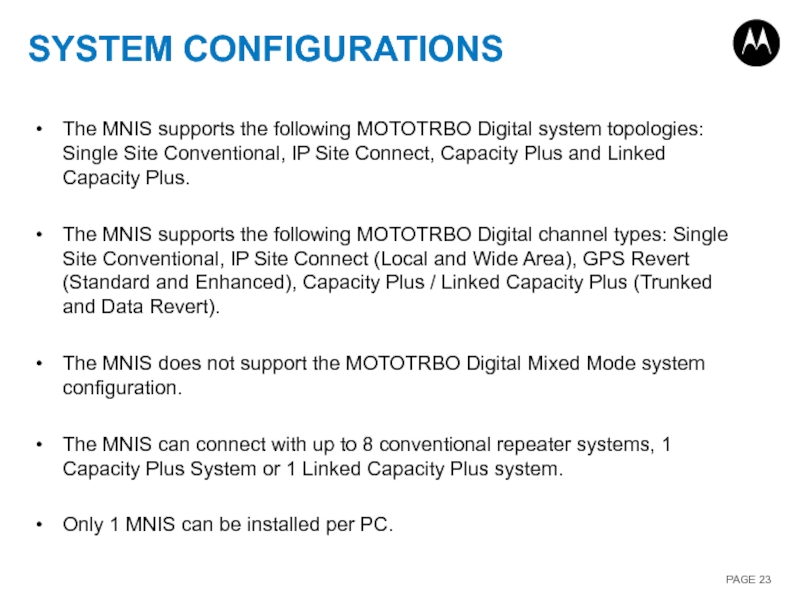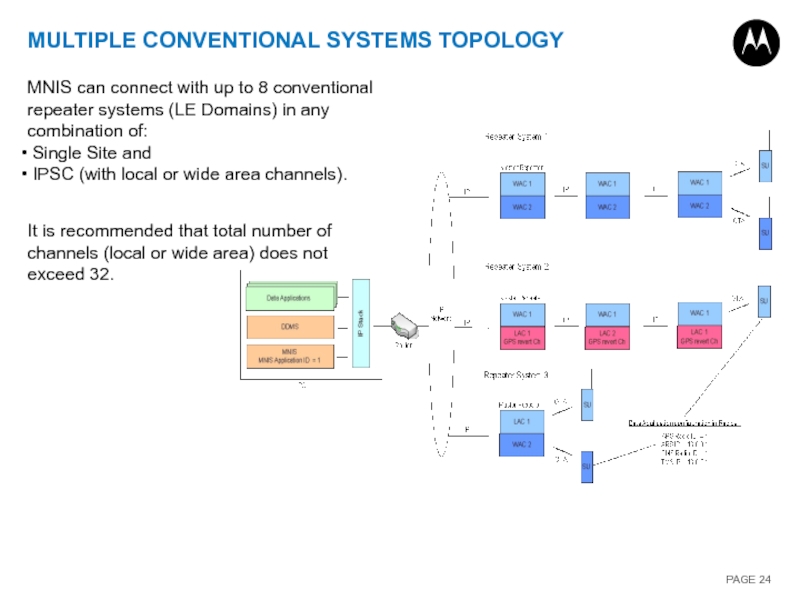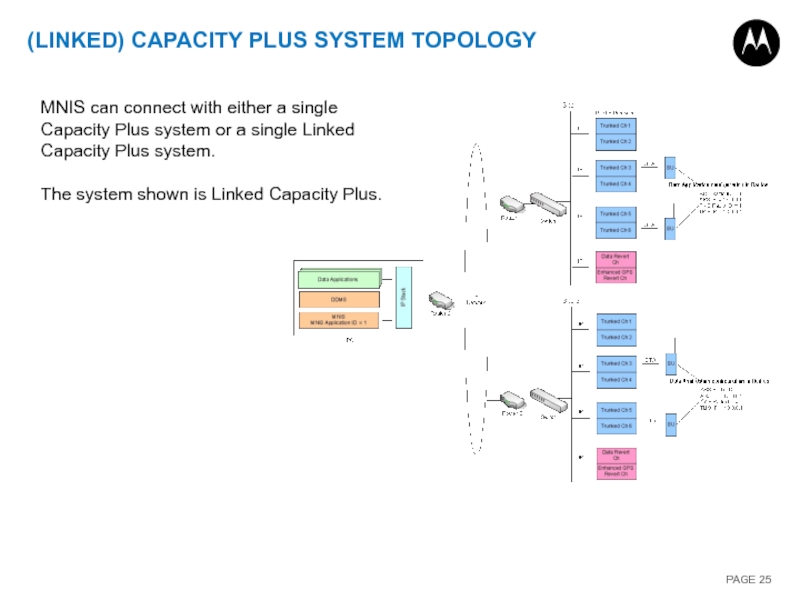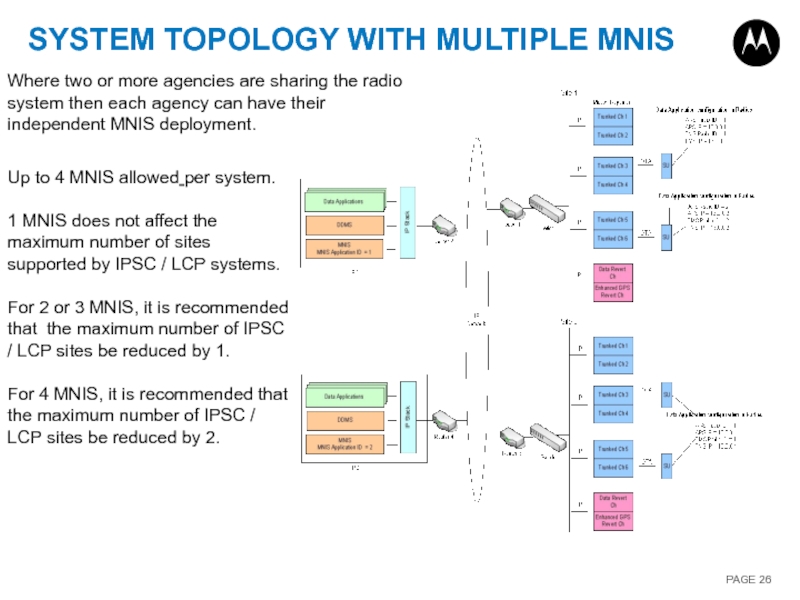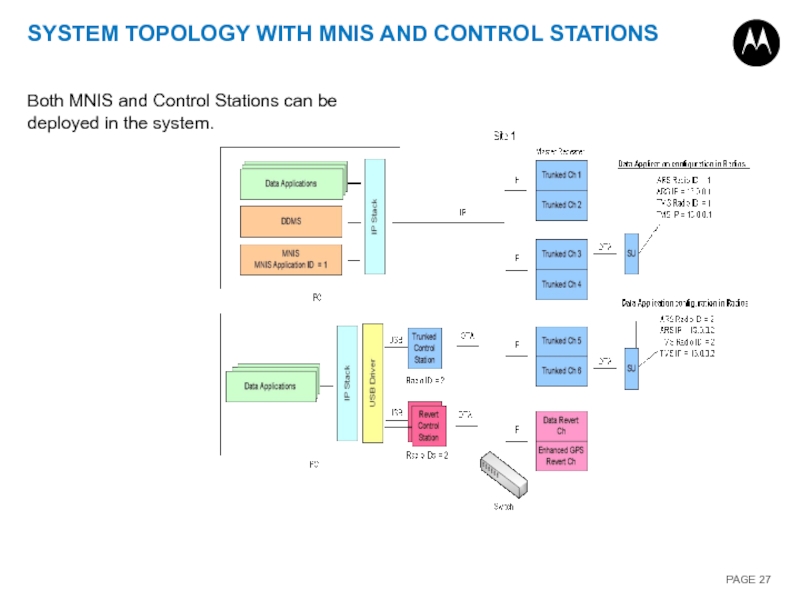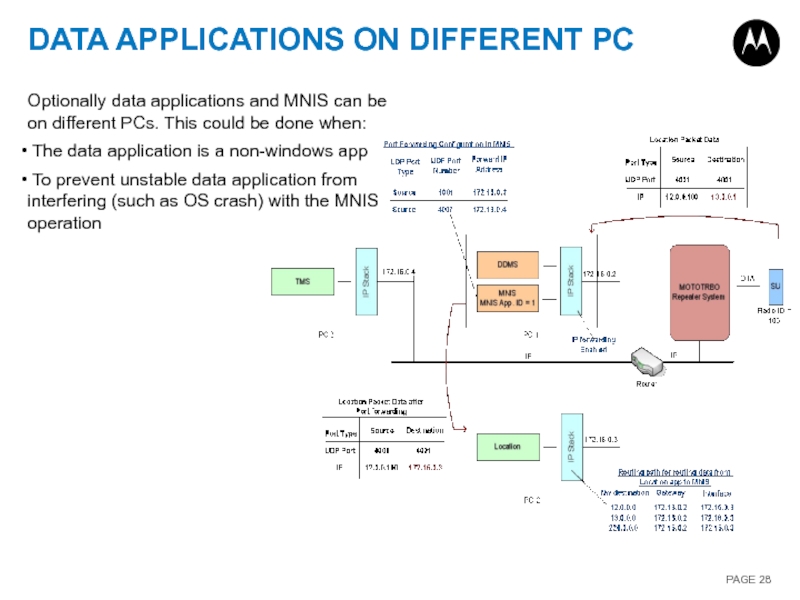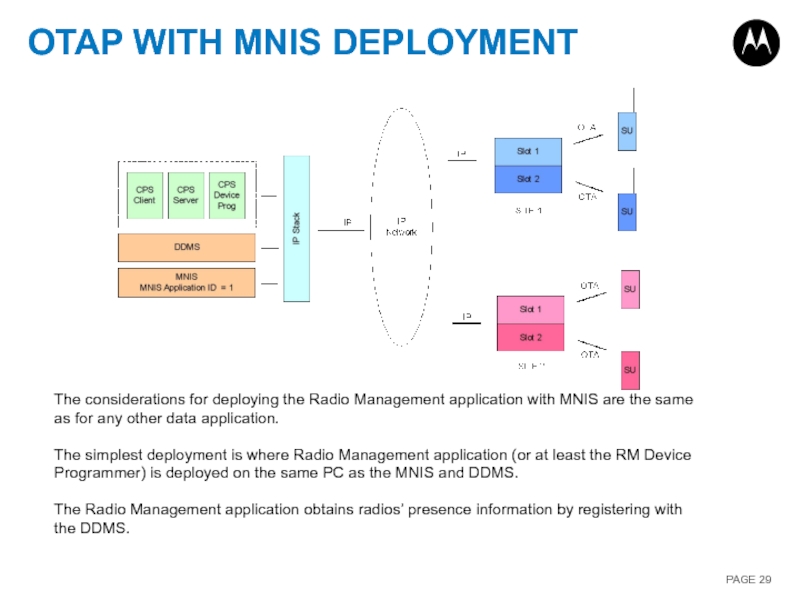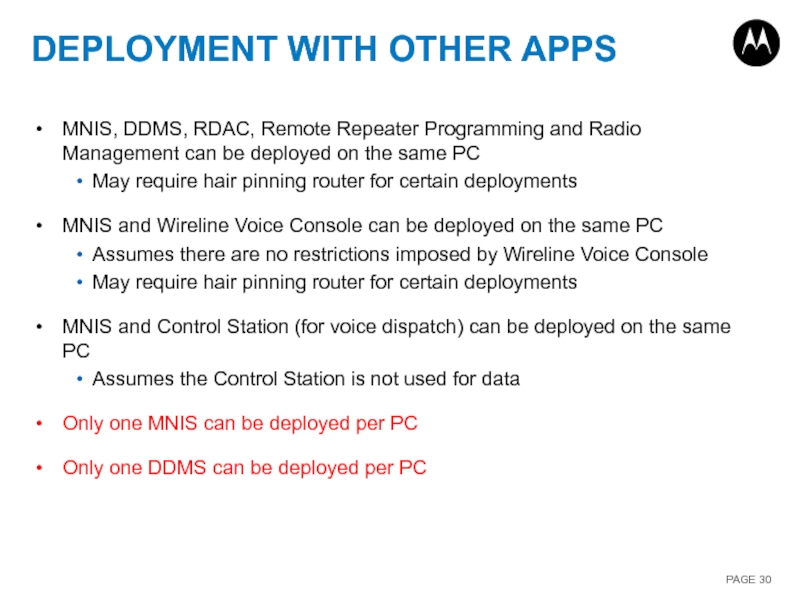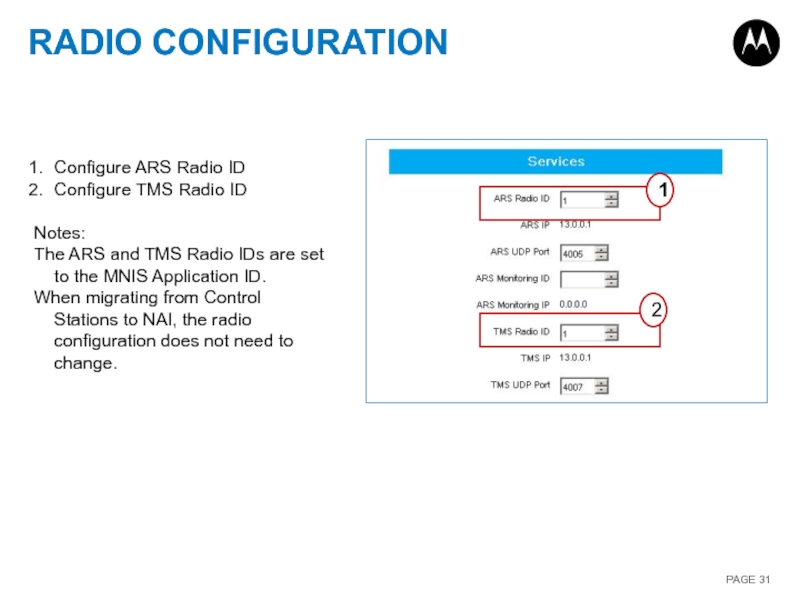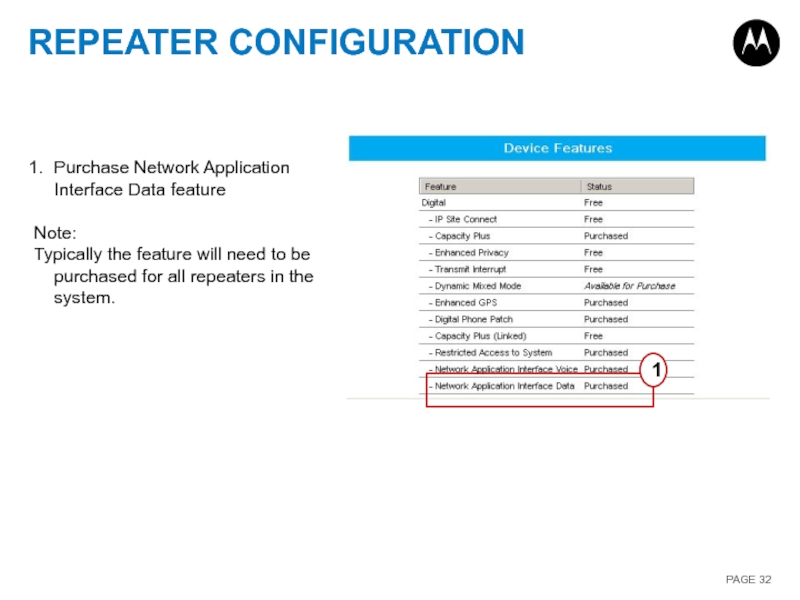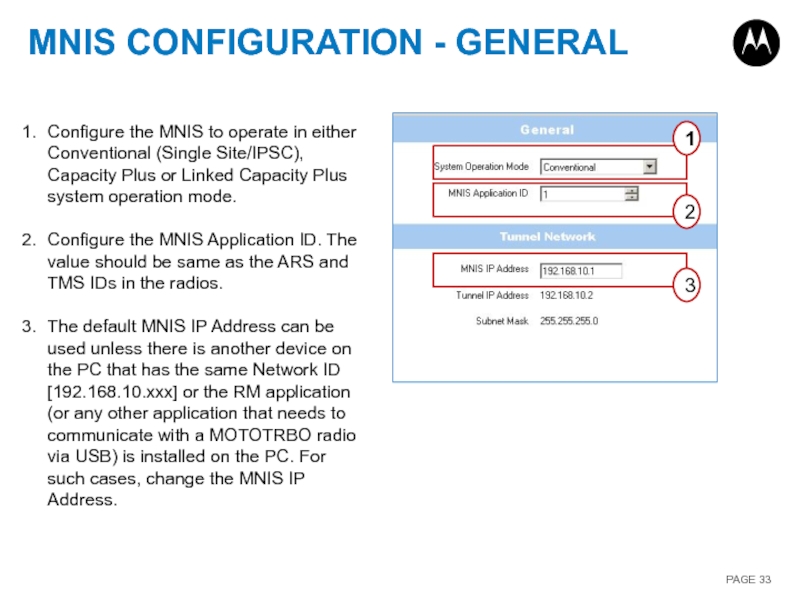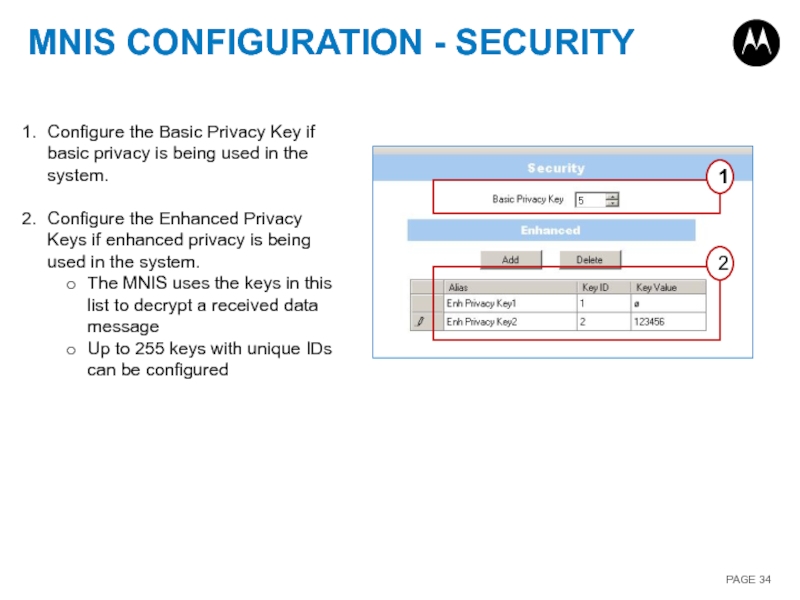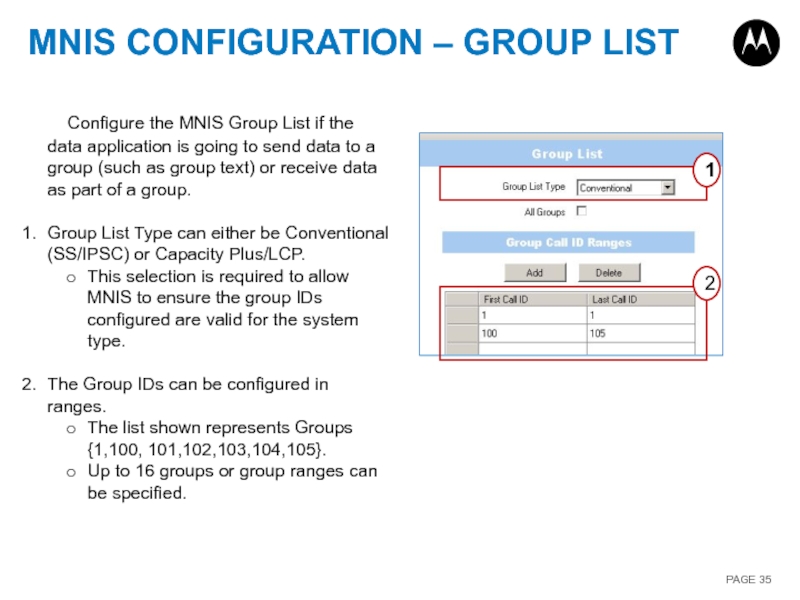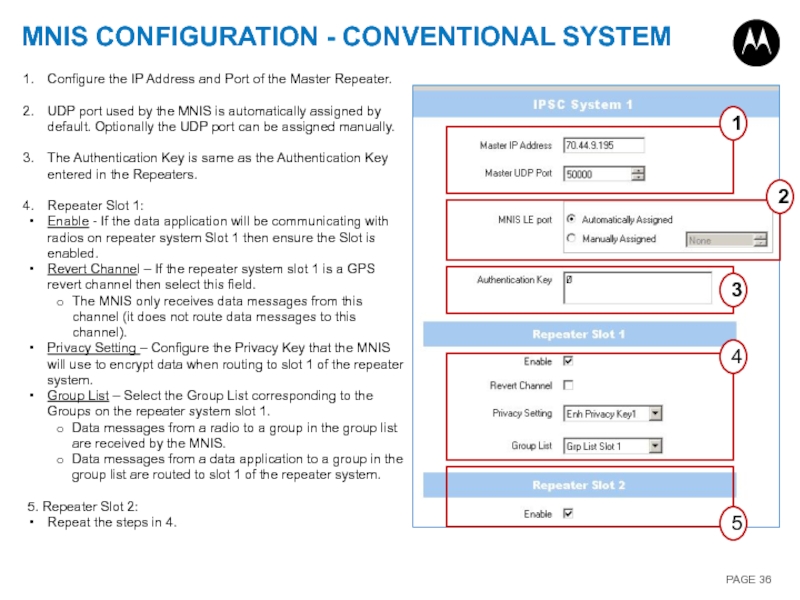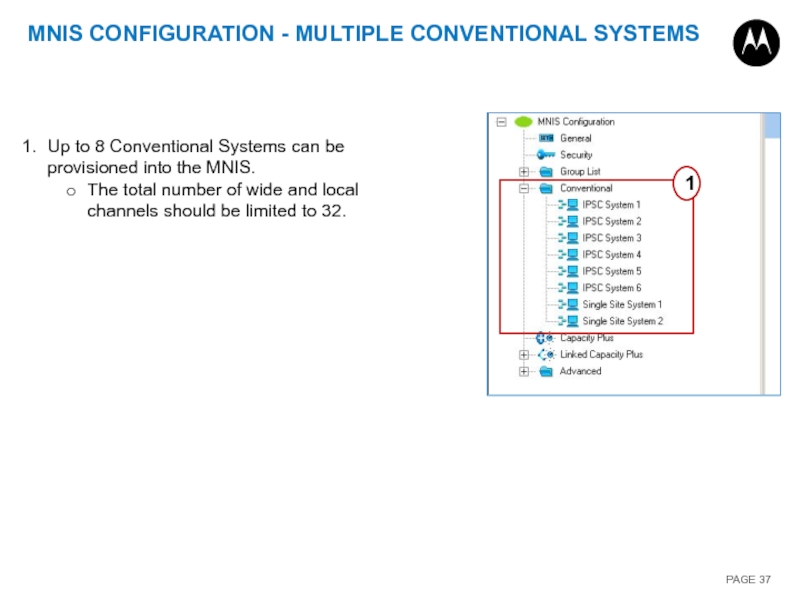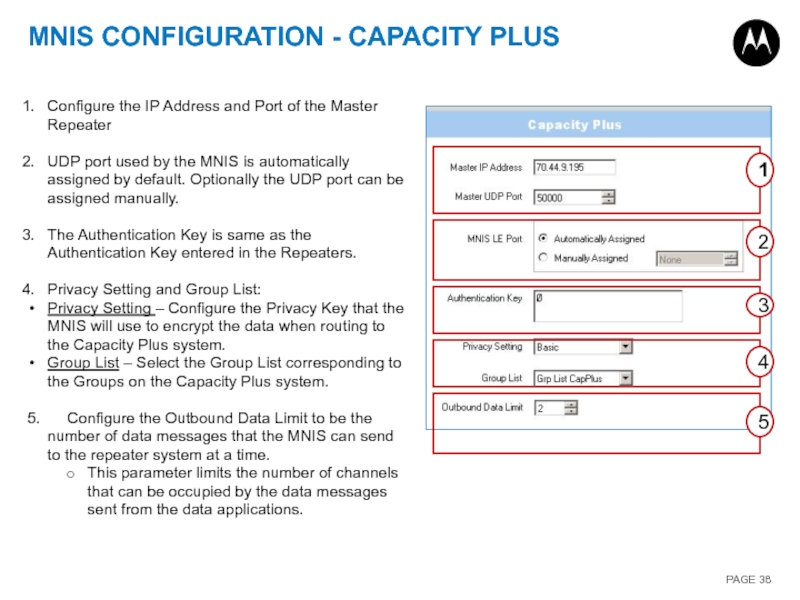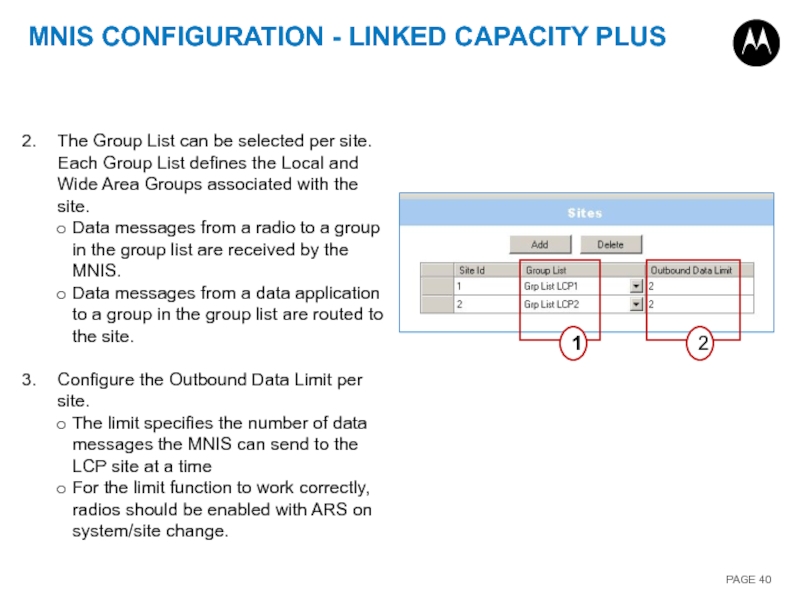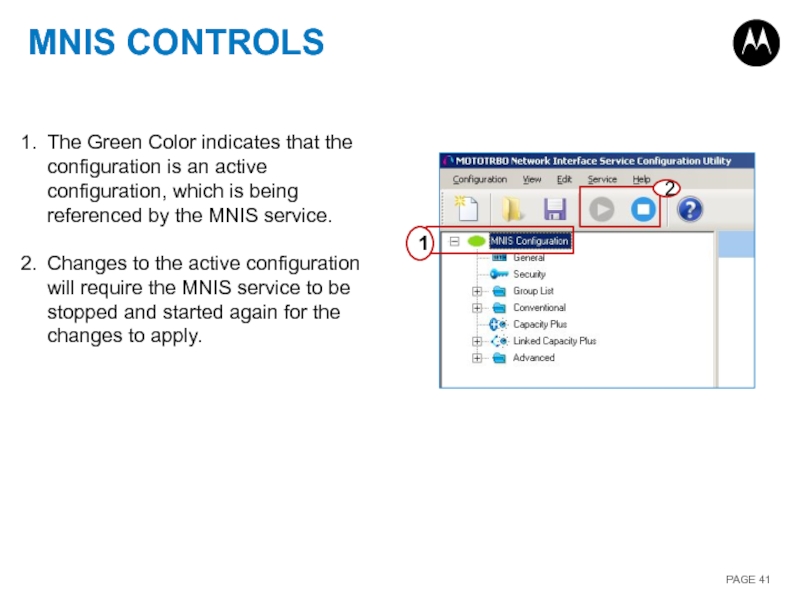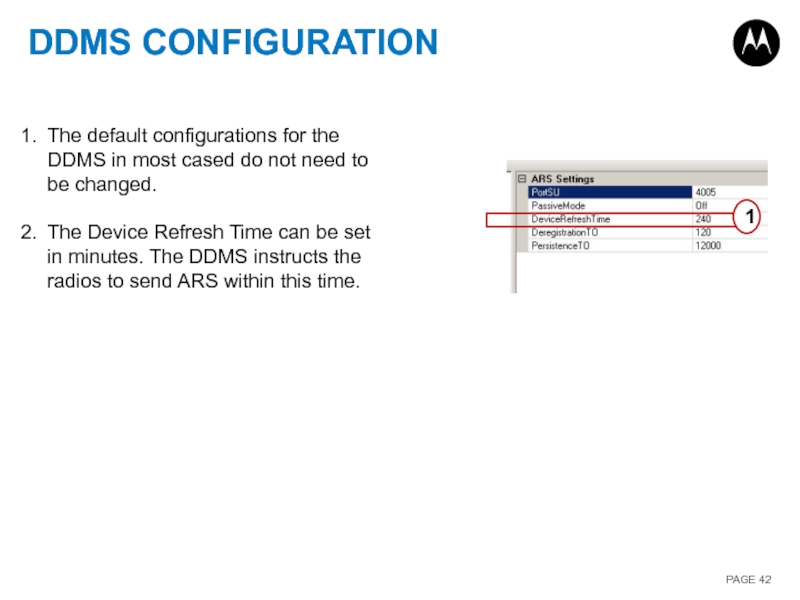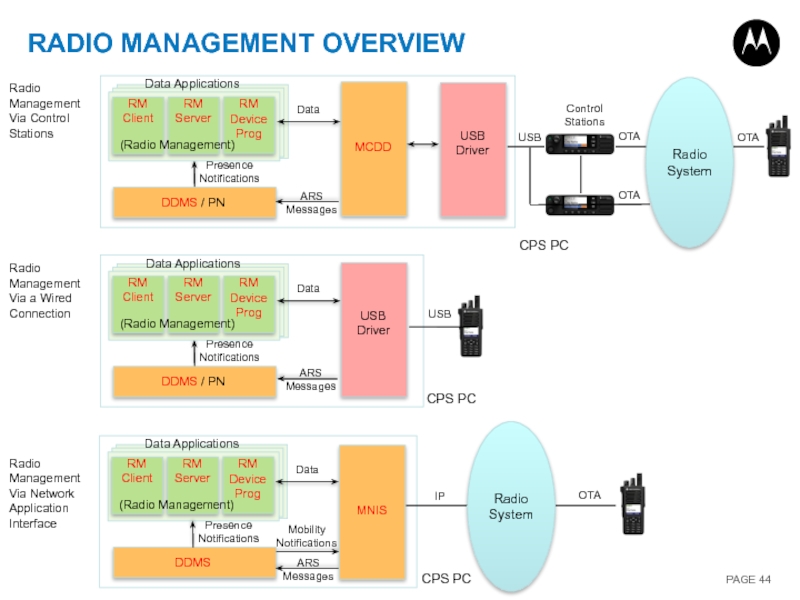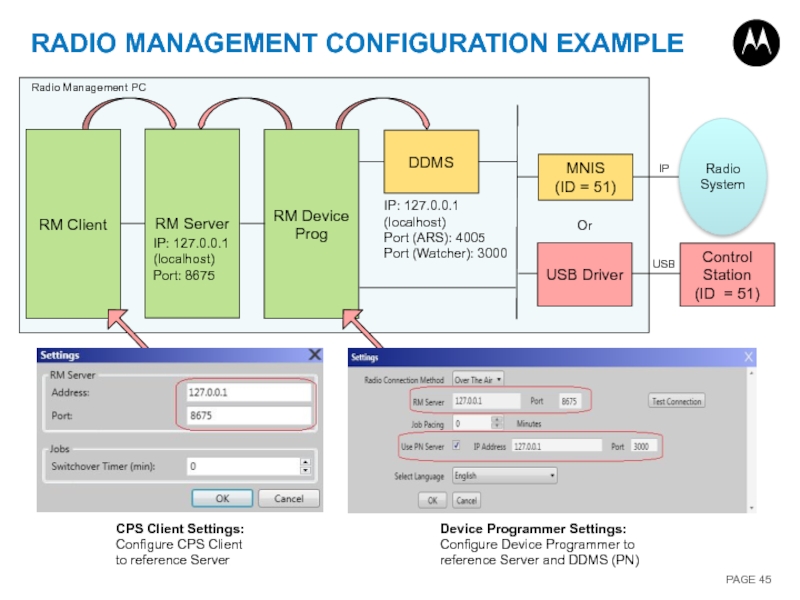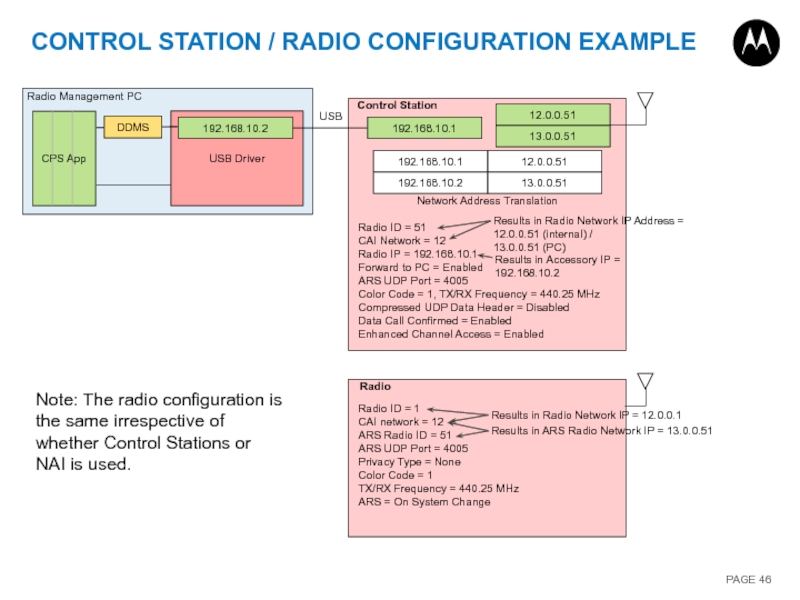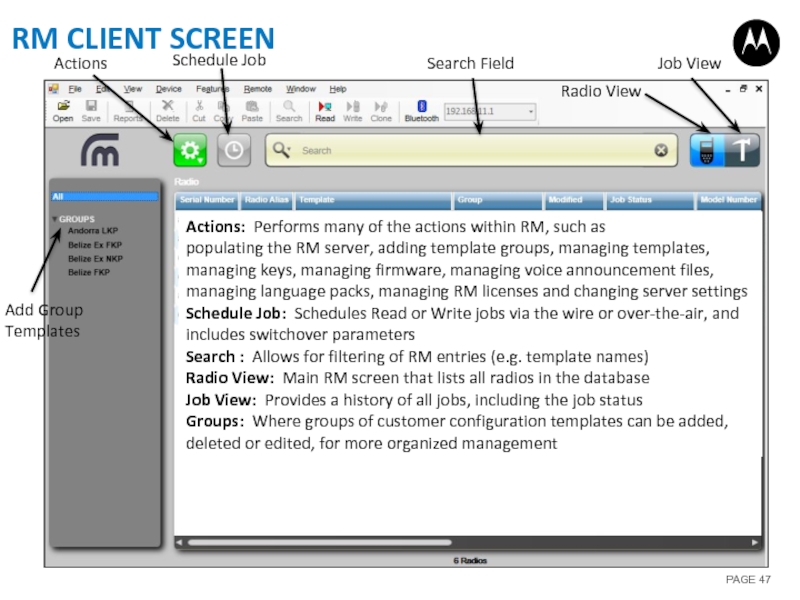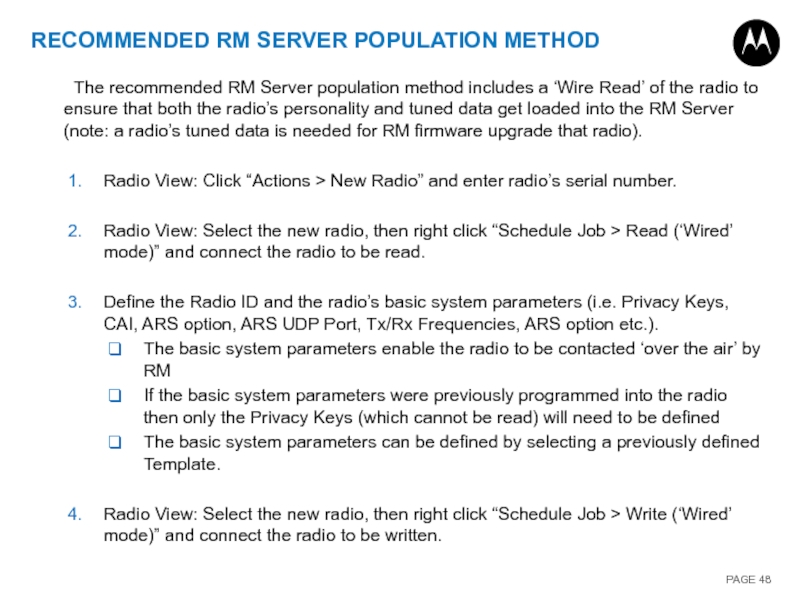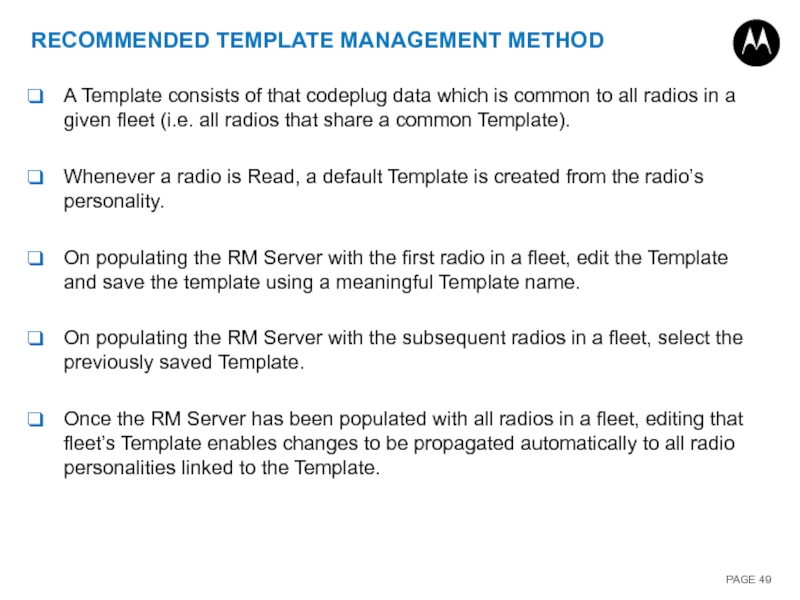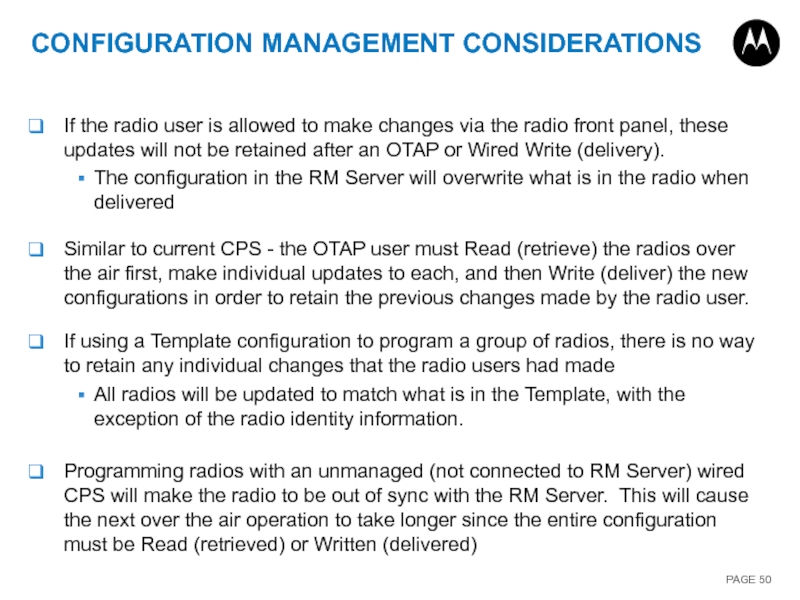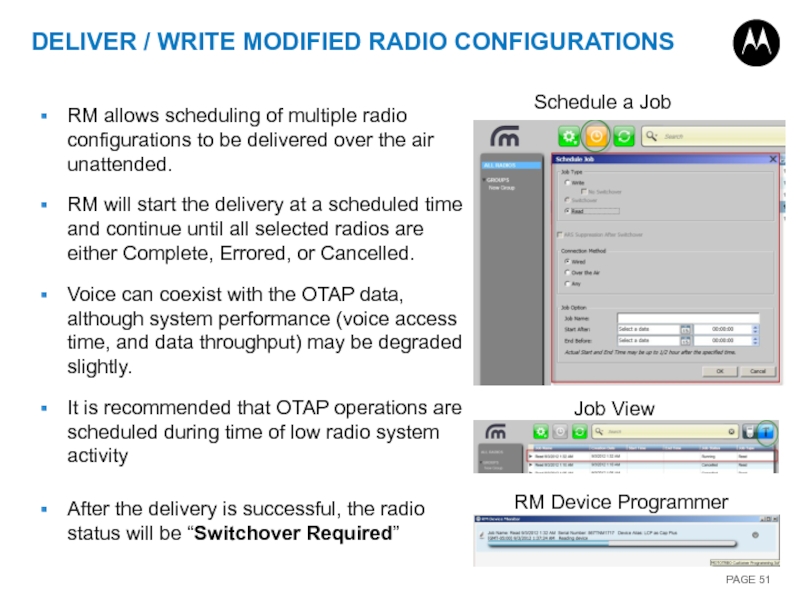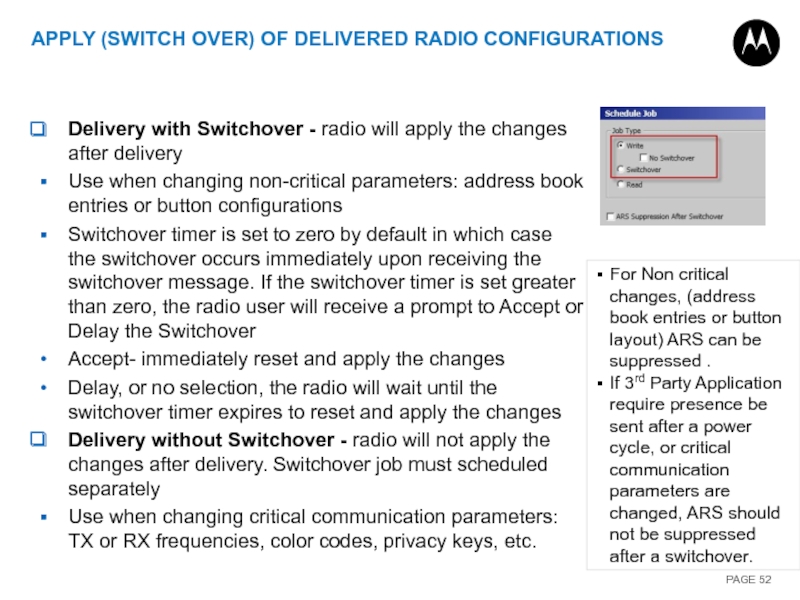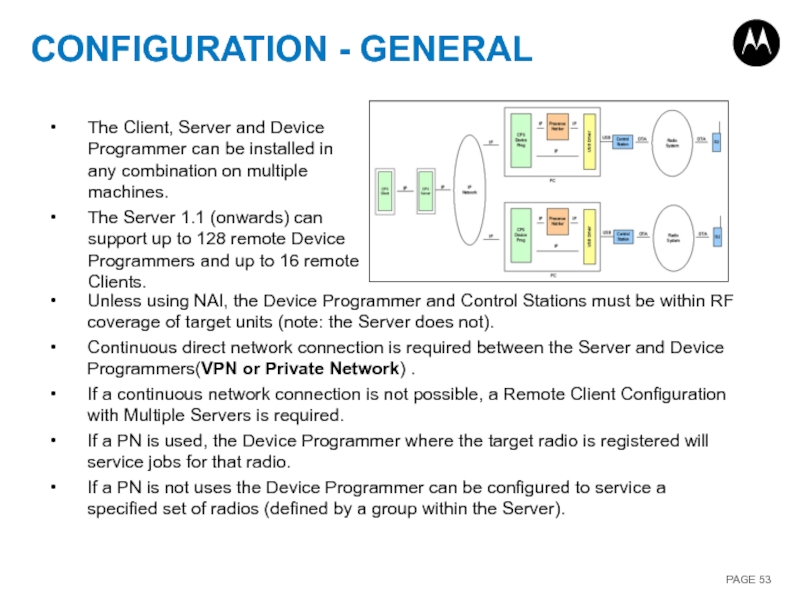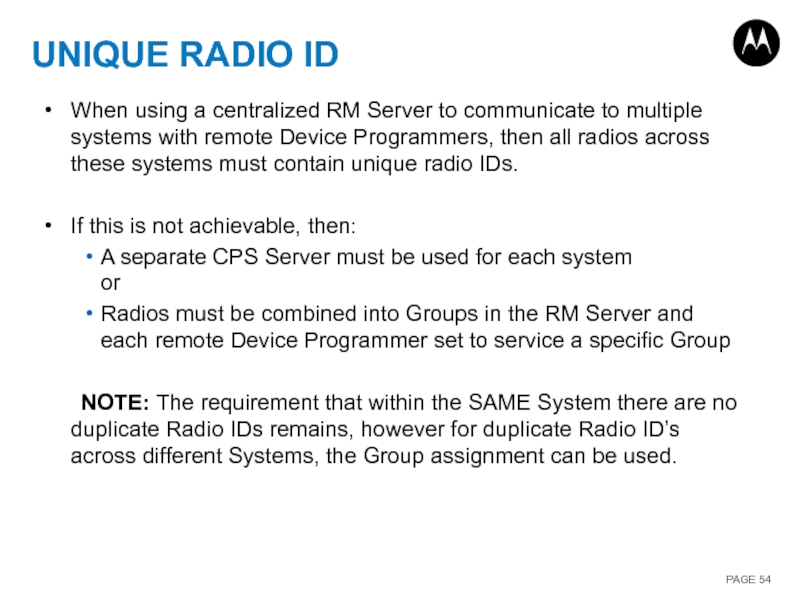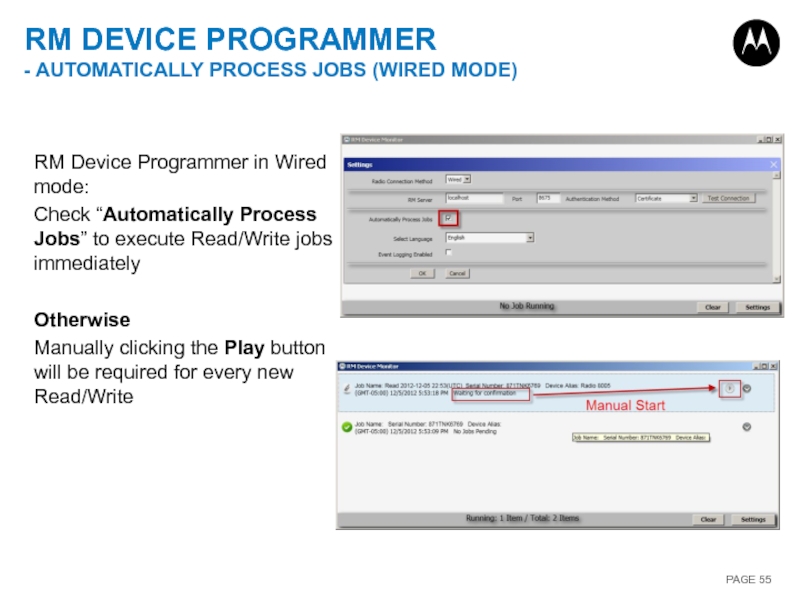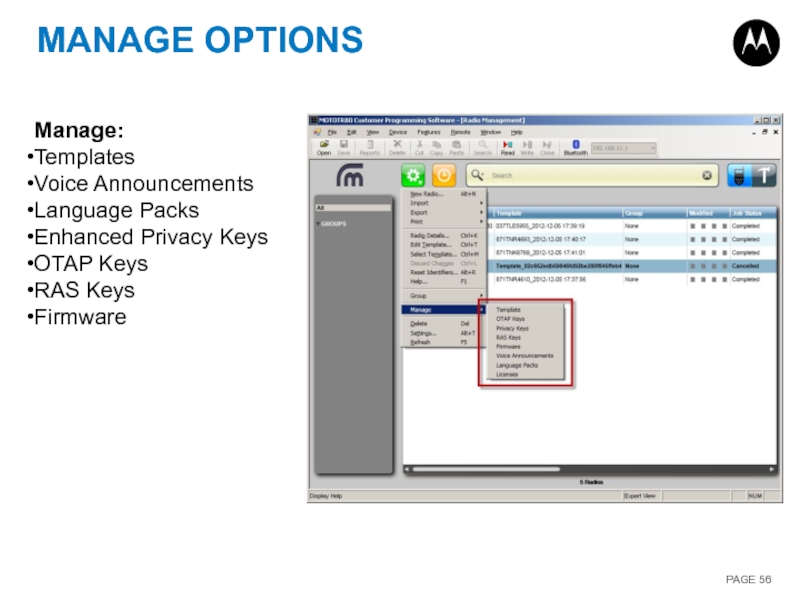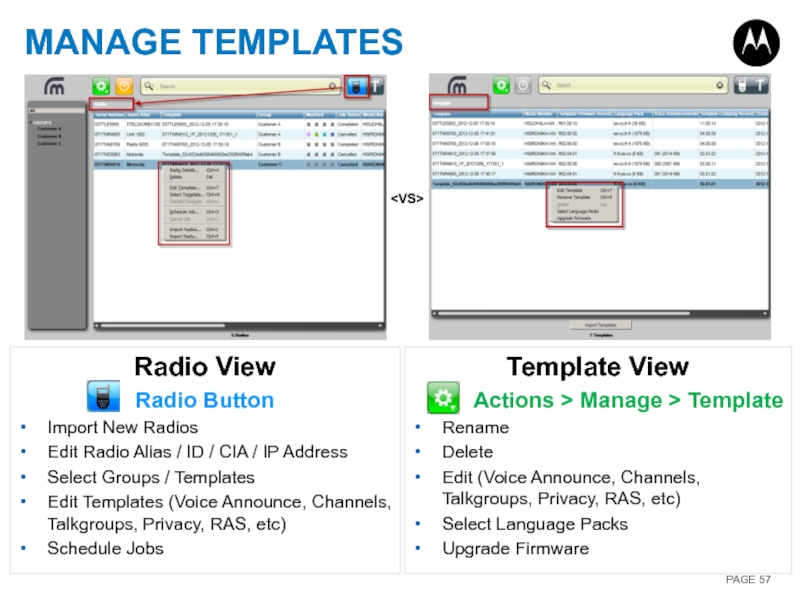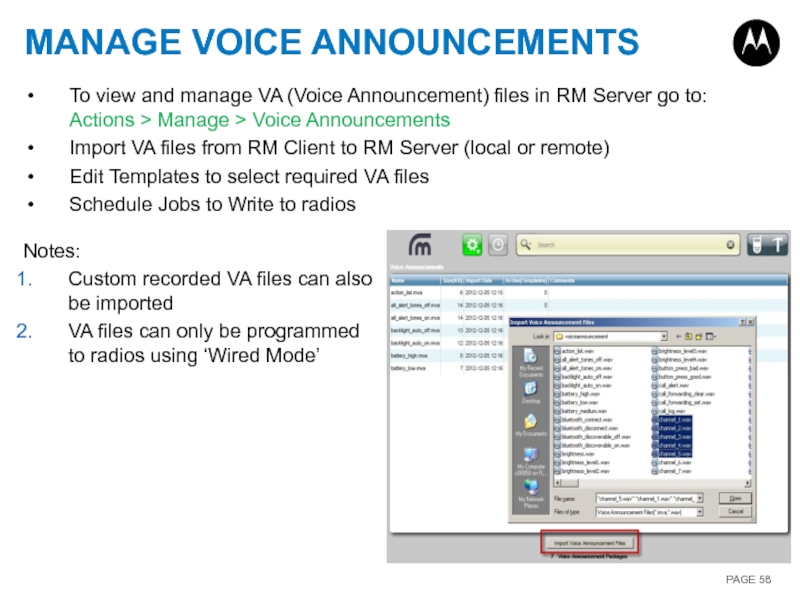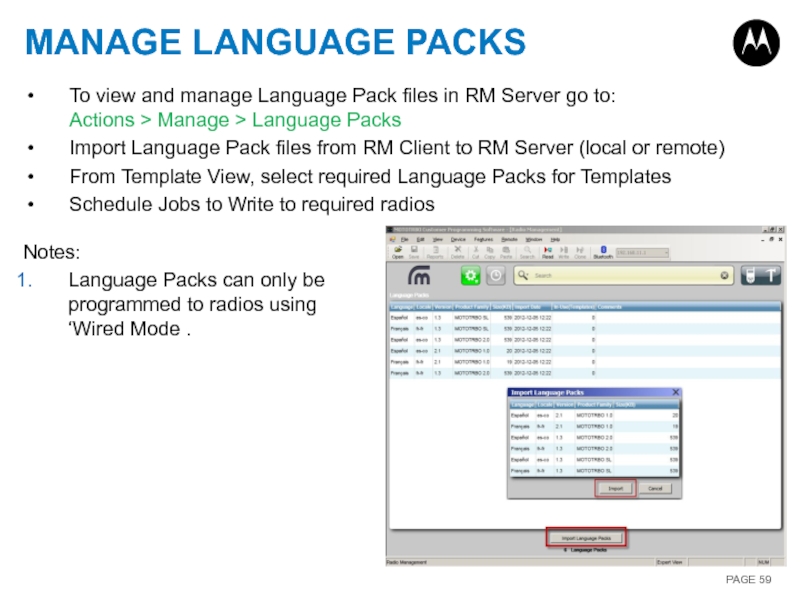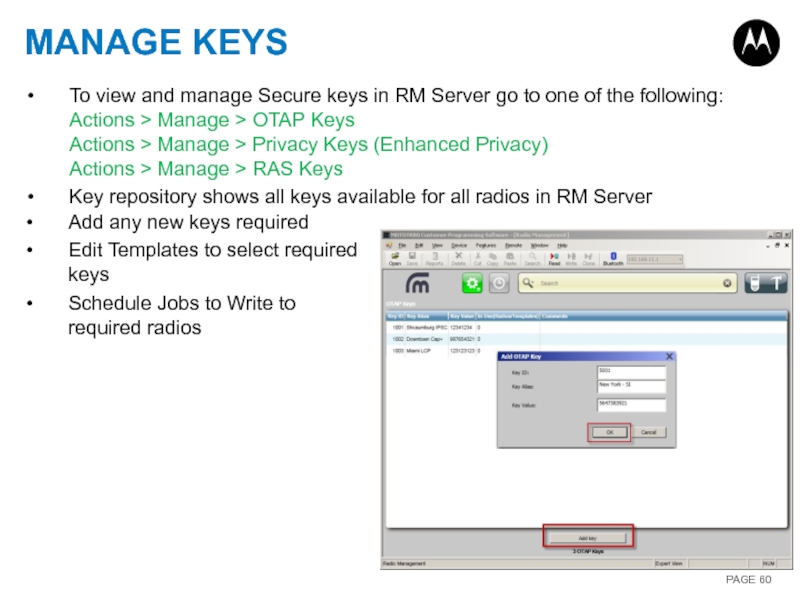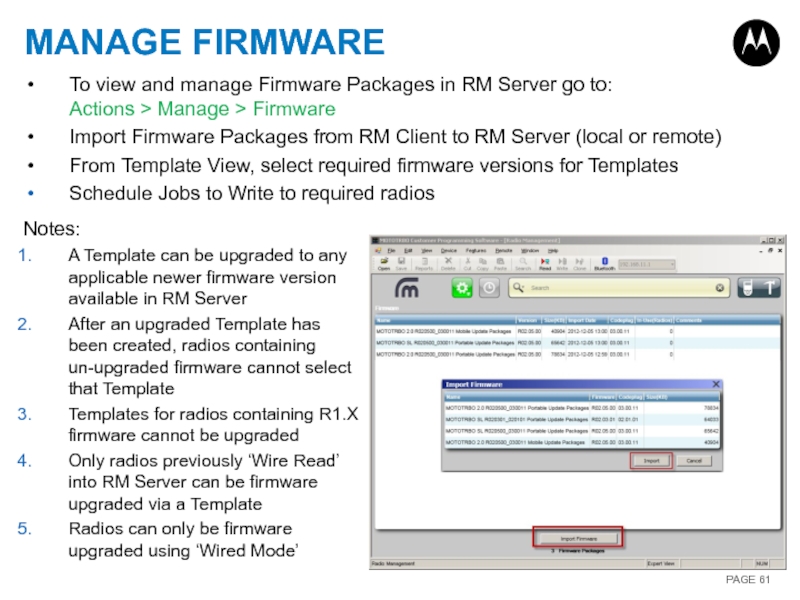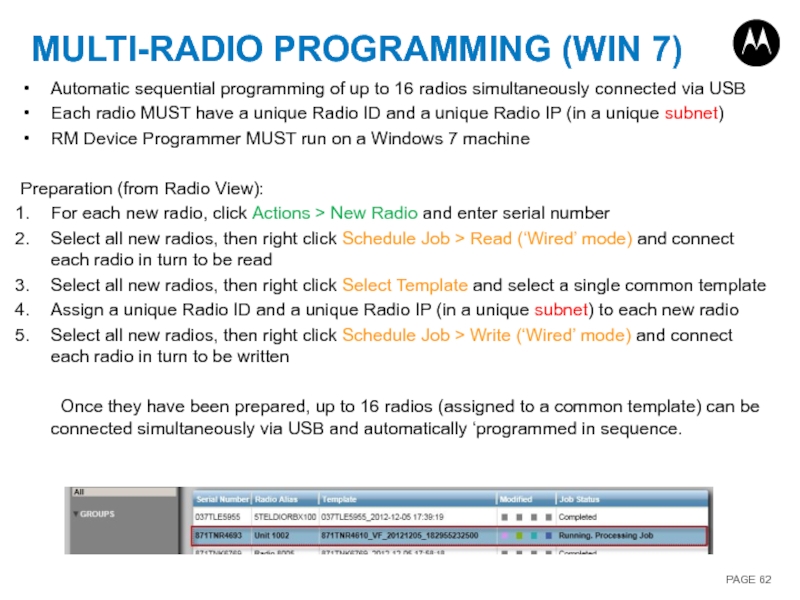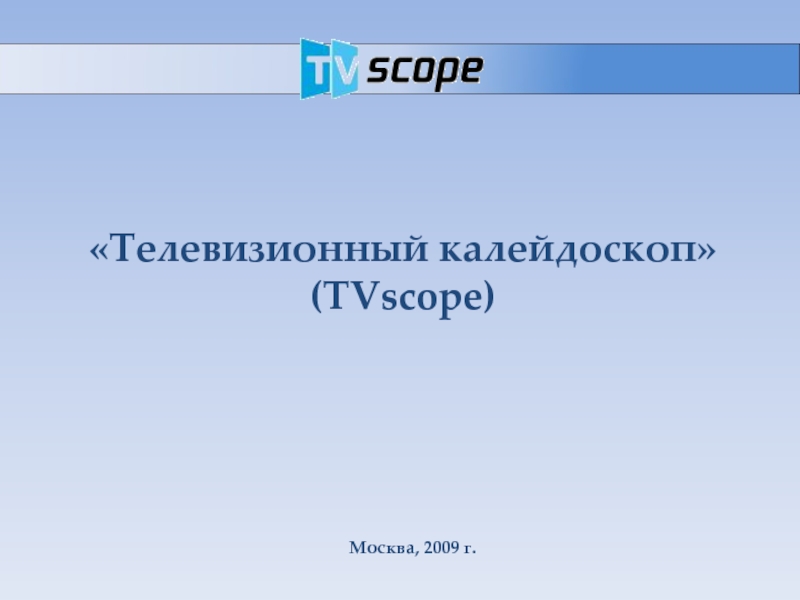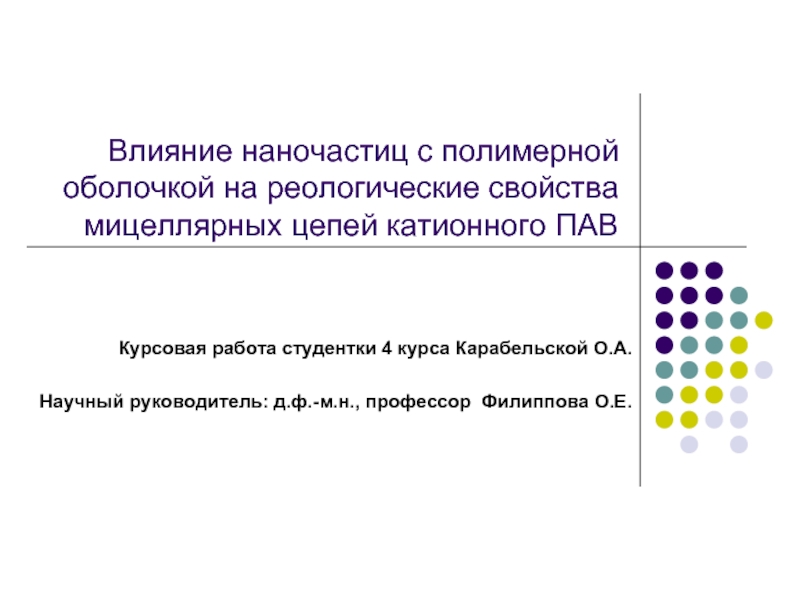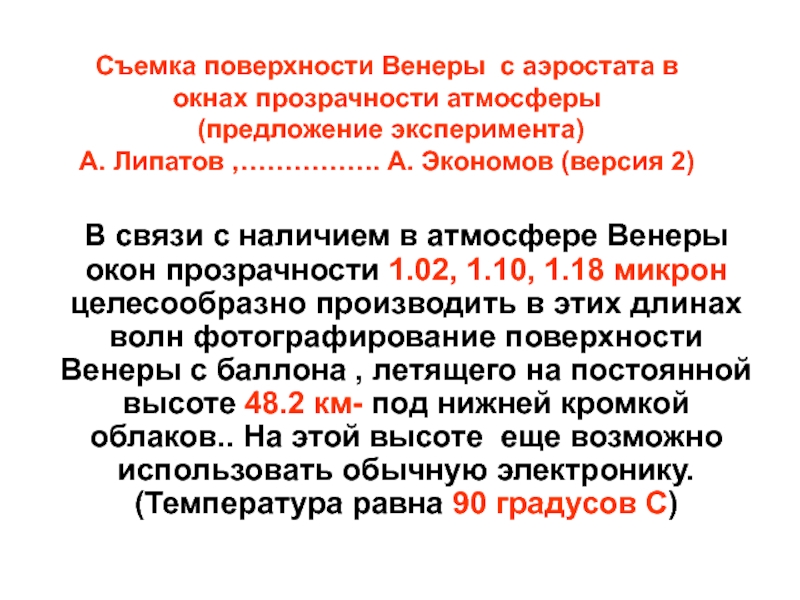- Главная
- Разное
- Дизайн
- Бизнес и предпринимательство
- Аналитика
- Образование
- Развлечения
- Красота и здоровье
- Финансы
- Государство
- Путешествия
- Спорт
- Недвижимость
- Армия
- Графика
- Культурология
- Еда и кулинария
- Лингвистика
- Английский язык
- Астрономия
- Алгебра
- Биология
- География
- Детские презентации
- Информатика
- История
- Литература
- Маркетинг
- Математика
- Медицина
- Менеджмент
- Музыка
- МХК
- Немецкий язык
- ОБЖ
- Обществознание
- Окружающий мир
- Педагогика
- Русский язык
- Технология
- Физика
- Философия
- Химия
- Шаблоны, картинки для презентаций
- Экология
- Экономика
- Юриспруденция
Motorola solutions learning. Network application interface (NAI). Radio management (RM) презентация
Содержание
- 1. Motorola solutions learning. Network application interface (NAI). Radio management (RM)
- 2. SECTIONS 1. Introduction: High Level Overview / Demo
- 3. INTRODUCTION
- 4. Mobility Notifications Presence Notifications ARS Messages Data
- 5. NETWORK APPLICATION INTERFACE (NAI)
- 6. FEATURE SUMMARY Network Application Interface The
- 7. FEATURE SUMMARY Requires a software upgrade of
- 8. NETWORK APPLICATION INTERFACE – VOICE/CSBK 3rd party
- 9. NETWORK APPLICATION INTERFACE – VOICE/CSBK A Wireline
- 10. NETWORK APPLICATION INTERFACE – DATA The Network
- 11. MNIS OVERVIEW The MNIS is supported by
- 12. MNIS OVERVIEW The MNIS connects with the
- 13. MNIS APPLICATION ID The MNIS has an
- 14. DDMS OVERVIEW The DDMS is supported by
- 15. DDMS WATCHER INTERFACE The DDMS maintains both
- 16. RADIO MANAGEMENT (RM) All MOTOTRBO radios can
- 17. RADIO MANAGEMENT OVERVIEW Radio Management (RM) is
- 18. RADIO MANAGEMENT (RM) SOFTWARE LICENSES The Radio
- 19. IMPORTING RM LICENSES Total Available Entries
- 20. TECHNICAL
- 21. NETWORK APPLICATION INTERFACE (NAI)
- 22. DATA FLOW 1. The Location Application subscribes
- 23. SYSTEM CONFIGURATIONS The MNIS supports the following
- 24. MULTIPLE CONVENTIONAL SYSTEMS TOPOLOGY MNIS can connect
- 25. (LINKED) CAPACITY PLUS SYSTEM TOPOLOGY MNIS can
- 26. SYSTEM TOPOLOGY WITH MULTIPLE MNIS Where two
- 27. SYSTEM TOPOLOGY WITH MNIS AND CONTROL STATIONS
- 28. DATA APPLICATIONS ON DIFFERENT PC Optionally data
- 29. OTAP WITH MNIS DEPLOYMENT The considerations for
- 30. DEPLOYMENT WITH OTHER APPS MNIS, DDMS, RDAC,
- 31. RADIO CONFIGURATION Configure ARS Radio ID Configure
- 32. REPEATER CONFIGURATION 1 Purchase Network Application
- 33. MNIS CONFIGURATION - GENERAL 1
- 34. MNIS CONFIGURATION - SECURITY 1
- 35. MNIS CONFIGURATION – GROUP LIST 1
- 36. MNIS CONFIGURATION - CONVENTIONAL SYSTEM 1
- 37. MNIS CONFIGURATION - MULTIPLE CONVENTIONAL SYSTEMS
- 38. MNIS CONFIGURATION - CAPACITY PLUS 1
- 39. MNIS CONFIGURATION - LINKED CAPACITY PLUS 1. The
- 40. MNIS CONFIGURATION - LINKED CAPACITY PLUS
- 41. MNIS CONTROLS 1 2 The
- 42. DDMS CONFIGURATION The default configurations for the
- 43. RADIO MANAGEMENT (RM) All MOTOTRBO radios can
- 44. USB OTA USB RADIO MANAGEMENT OVERVIEW Presence
- 45. RADIO MANAGEMENT CONFIGURATION EXAMPLE
- 46. USB Driver CONTROL STATION /
- 47. RM CLIENT SCREEN Actions Schedule Job Radio
- 48. RECOMMENDED RM SERVER POPULATION METHOD The recommended
- 49. RECOMMENDED TEMPLATE MANAGEMENT METHOD A Template consists
- 50. CONFIGURATION MANAGEMENT CONSIDERATIONS If the radio user
- 51. RM allows scheduling of multiple radio configurations
- 52. Delivery with Switchover - radio will apply
- 53. CONFIGURATION - GENERAL Unless using NAI, the
- 54. UNIQUE RADIO ID When using a centralized
- 55. RM DEVICE PROGRAMMER - AUTOMATICALLY PROCESS JOBS
- 56. MANAGE OPTIONS Manage: Templates Voice Announcements Language
- 57. MANAGE TEMPLATES Radio View Radio Button Import
- 58. MANAGE VOICE ANNOUNCEMENTS To view and manage
- 59. MANAGE LANGUAGE PACKS To view and manage
- 60. MANAGE KEYS To view and manage Secure
- 61. MANAGE FIRMWARE To view and manage Firmware
- 62. MULTI-RADIO PROGRAMMING (WIN 7) Automatic sequential programming
- 63. THANK YOU… MOTOROLA, MOTO, MOTOROLA SOLUTIONS
Слайд 2SECTIONS
1. Introduction:
High Level Overview / Demo
Network Application Interface (NAI)
Radio Management (RM)
Technical:
Network Application
Radio Management (RM)
Слайд 4Mobility Notifications
Presence Notifications
ARS Messages
Data
(ADK)
Router/Switch
Site 2
Router/Switch
Site 1
NAI & RM ON THE LCP
Ch 1
NAI – D / NAI – V/C
Ch 2
CPS PC (Dealer Site)
IP Network
Master 11
Peer 12
Peer 21
Peer 22
Voice Console (3rd Party)
Voice Console PC
IP
(ADK)
IP
IP
IP
Ch 3
Ch 4
Ch 1
Ch 2
Ch 3
Ch 4
Data Applications
Repeaters
Switch
(Radio Management)
(1)
(2)
(3)
(4)
(5)
(6)
NAI – D / NAI – V/C
NAI – D / NAI – V/C
NAI – D / NAI – V/C
Слайд 6FEATURE SUMMARY
Network Application Interface
The Network Application Interface is an IP
MOTOTRBO Network Interface Service (MNIS)
The MNIS is Motorola Solutions supplied windows application, which acts as Data Gateway (middleware) between the data applications (including the DDMS) and the radio system.
Data messages between the data applications (including the DDMS) and the radio system are routed through the MNIS.
MOTOTRBO Device Discovery and Mobility Service (DDMS)
The DDMS is Motorola Solutions supplied application, which replaces Presence Notifier (PN) application and provides radio presence and mobility tracking services.
The DDMS interfaces to the radio system through the MNIS.
Data Applications
Data applications such as Text, Location, Telemetry, etc..
These apps are primarily supplied by 3rd party vendors, but can also be Motorola Solutions supplied apps such as RM (OTAP).
Data applications interface to the radio system through the MNIS.
Voice Console
Voice consoles are supplied by 3rd party vendors and interface directly to the radio system (Motorola Solutions does not provide middleware for voice).
The RDAC, Remote Repeater Programming CPS and Call Monitoring Apps do not utilize the Network Application Interface.
Слайд 7FEATURE SUMMARY
Requires a software upgrade of repeaters:
Repeaters must have 32MB of
Compatible with current and next generation MOTOTRBO radios
Requires feature activation in the repeater:
HKVN4211A DR 3000 NAI for Voice/CSBK License Key
HKVN4212A DR 3000 NAI for Data License Key
HKVN4214A MTR3000 NAI for Voice/CSBK License Key
HKVN4215A MTR3000 NAI for Data License Key
ADK documentation for the following interfaces is maintained and made available via the Application Developers Program:
Network Application Interface for Voice/CSBK*
MNIS interface (to access the Network Application Interface for Data)
The MNIS / DDMS software is released via the MOTOTRBO MOL website
(* to selected 3rd party application developers)
Слайд 8NETWORK APPLICATION INTERFACE – VOICE/CSBK
3rd party Wireline Voice Consoles utilizing the
Group Call
Private Call or Confirmed Private Call
All Call
Voice Privacy (Basic and Enhanced)
CSBK calls – Radio Check , Call Alert, Remote Monitor, Radio Inhibit/Inhibit, Voice Console Enable/Disable
The Interface allows 3rd party Wireline Voice Consoles to interrupt or impolitely takeover on-going Voice calls.
Where a Wireline Voice Console is required to interface to a given system site then all Voice Capable repeaters at that site must have their “Network Application Interface for Voice/CSBK” feature enabled using the CPS. Where a Wireline Voice Console is not required to interface to a given system site, then repeaters at that site do not need to have this feature enabled.
NOTES:
Voice Capable repeaters are all repeaters except for data revert repeaters and repeaters where both slots are GPS revert slots.
A Wireline Voice Console counts as 1 site, so the total number of IPSC/LCP sites plus Wireline Voice Consoles should not exceed 15.
Support for Telephone calls (similar to Digital Telephone Patch) via this interface is a future roadmap feature.
Слайд 9NETWORK APPLICATION INTERFACE – VOICE/CSBK
A Wireline Voice Console is required to
Motorola Solutions does not provide middleware for Wireline Voice Consoles.
A Wireline Voice Console is also required to support AMBE vocoding.
The above requirements add complexity to the Wireline Voice Console, so to ensure high quality fully supported implementations, Motorola provides support to selected 3rd party application developers as follows:
By making available the “Network Application Interface for Voice/CSBK”.
By providing the necessary technical training and support.
Слайд 10NETWORK APPLICATION INTERFACE – DATA
The Network Application Interface for Data is
The MNIS provides 3rd party vendors with an ADK for accessing the Network Application Interface for Data (i.e. 3rd party applications do not access the interface directly).
The interface between a data application and MNIS is very similar to the interface between a data application and control station for the case where the data application uses the MCDD and MOTOTRBO Presence Notifier.
Слайд 11MNIS OVERVIEW
The MNIS is supported by Windows XP, Windows 7, Windows
The MNIS supports the following MOTOTRBO data features:
Layer 2 confirmed and unconfirmed data message delivery
Individual and Group data messages
Basic and Enhanced Privacy
Data message IP/UDP header compression
Data Precedence and Data over Voice Interrupt access priority
Compared to Control stations, the advantages of using MNIS for data are:
The deployment is simpler – no extra hardware
The data application does not need to be within the RF coverage area of the system
Data revert channels can be configured to be local – Increases GPS capacity
MNIS connectivity with the system can be monitored via RDAC
Customers not wishing to use the Network Application Interface for Data feature shall still have the option of using Control Stations.
Слайд 12MNIS OVERVIEW
The MNIS connects with the repeater system using the Link
This requires the MNIS to be configured with the Master repeater’s IP address and UDP port number.
Upon connection with the Master repeater, the MNIS discovers the IP addresses and port numbers of all the repeaters in the system then establishes links with all the repeaters in the system.
Upon connection with the repeaters, the MNIS uses the repeater’s Network Application Interface and its underlying services to support data transmit and receive through the repeaters.
The Link Establishment and Network Application Interface procedures are transparent to the data application.
Where a MNIS is required to interface to a given system site then all repeaters at that site must have their “Network Application Interface for Data” feature enabled using the CPS. Where MINS is not required to interface to a given system site, then repeaters at that site do not need to have this feature enabled.
The MNIS Configuration GUI allows configuration of system link establishment parameters such as Master IP Address, Port, Peer ID, etc.
Слайд 13MNIS APPLICATION ID
The MNIS has an identifier, called the MNIS Application
The ID is configured in the MNIS using the MNIS configuration GUI.
The ID is used by the MNIS to receive and transmit on the radio network.
Whenever a radio needs to communicate with the data application (or vice versa) the MNIS Application ID is used.
For example, the ARS and TMS Radio ID fields in a radio need to be configured with the MNIS Application ID such that data messages from a radio to the ARS or TMS applications contain the MNIS Application ID as the destination address.
Likewise, data messages from the ARS or TMS applications to a radio need to have the MNIS Application ID as the source address.
The MNIS application ID is akin to the Radio ID of a control station.
Fielded radios should not be configured with a Radio ID that matches the MNIS Application ID.
Слайд 14DDMS OVERVIEW
The DDMS is supported by Windows XP, Windows 7, Windows
The DDMS replaces the legacy Presence Notifier (PN) application.
The DDMS is backward compatible with the Presence Notifier such that existing applications that interface with the Presence Notifier do not require any changes to receive presence notifications from the DDMS.
The DDMS can be deployed with a Control Station or the MNIS.
When deployed with a Control Station, the DDMS supports only radio presence notifications.
When deployed with the MNIS, the DDMS supports both presence notifications and mobility notifications.
A presence notification indicates a radio’s presence or absence in the radio system.
A mobility notification indicates the channel/site from which a radio transmits its ARS Device Registration message.
When transmitting messages to a radio from a data application, the MNIS uses a radio’s mobility information (supplied by the DDMS) to determine the channel/site to use.
Besides the MNIS, other applications can also receive a radio’s mobility information from the DDMS.
Слайд 15DDMS WATCHER INTERFACE
The DDMS maintains both the radio presence and mobility
The DMMS provides a Watcher interface to enable applications to obtain radios’ presence and mobility information and notifications of changes in radios’ presence and mobility information.
Presence Information:
The MNIS forwards a radio’s ARS message to the DDMS which updates the radios presence information.
The DDMS notifies data applications that have subscribed for presence through the Watcher interface.
Mobility Information:
The MNIS forwards a radio’s ARS message to the DDMS which updates the radios mobility information.
The DDMS notifies data applications (including the MNIS) that have subscribed for mobility through the Watcher interface.
Слайд 16RADIO MANAGEMENT (RM)
All MOTOTRBO radios can be managed and programmed /
Слайд 17RADIO MANAGEMENT OVERVIEW
Radio Management (RM) is an extension of the MOTOTRBO
RM Client is a window into RM and is accessed through the CPS > File menu.
RM Server stores codeplugs and templates and pre-processes jobs.
RM Device Programmer acts as the programming interface to the radios.
MOTOTRBO Network Interface Service (MNIS) is the NAI Data Gateway (middleware) between the data applications and the radio system.
MOTOTRBO Device Discovery & Mobility Service (DDMS) replaces the Presence Notifier (PN) and provides radio presence and mobility tracking services.
Multi Channel Device Driver (MCDD) tracks the location of radios as they move from channel to channel and updates the IP routing accordingly.
Note: All the above are included on the CPS DVD GMVN5141_ and are also available to download “Free of Charge” from Motorola Online.
Слайд 18RADIO MANAGEMENT (RM) SOFTWARE LICENSES
The Radio Management (RM) Server can store
Initial installation contains licenses for 10 radio archives by default
To add additional radio archives to RM for Wired or OTAP management and programming – additional licenses have to be purchased
HKVN4065A - block of licenses to add an additional 500 radio archives
Слайд 19IMPORTING RM LICENSES
Total Available Entries
Total Entries Used
Total Entries Unused
Actions >
Слайд 22DATA FLOW
1. The Location Application subscribes for radio presence information with
2. Upon power up the radio transmits an ARS message to register with the DDMS. The ARS message is received by the repeater and sent to the MNIS. The MNIS then routes the data message to the DDMS.
3. The DDMS notifies the Location Application of the radio’s presence and the MNIS of the radio’s mobility.
4. The Location Application sends a Location Request which gets routed to the MNIS. The MNIS uses the radio’s mobility information to determine where the Location Request needs to be transmitted and routes it to the appropriate repeater. The repeater then transmits the location request to the radio.
5. The radio transmits its Location updates which are received by the repeater and sent to the MNIS. The MNIS routes the location updates to the Location application.
Слайд 23SYSTEM CONFIGURATIONS
The MNIS supports the following MOTOTRBO Digital system topologies: Single
The MNIS supports the following MOTOTRBO Digital channel types: Single Site Conventional, IP Site Connect (Local and Wide Area), GPS Revert (Standard and Enhanced), Capacity Plus / Linked Capacity Plus (Trunked and Data Revert).
The MNIS does not support the MOTOTRBO Digital Mixed Mode system configuration.
The MNIS can connect with up to 8 conventional repeater systems, 1 Capacity Plus System or 1 Linked Capacity Plus system.
Only 1 MNIS can be installed per PC.
Слайд 24MULTIPLE CONVENTIONAL SYSTEMS TOPOLOGY
MNIS can connect with up to 8 conventional
Single Site and
IPSC (with local or wide area channels).
It is recommended that total number of channels (local or wide area) does not exceed 32.
Слайд 25(LINKED) CAPACITY PLUS SYSTEM TOPOLOGY
MNIS can connect with either a single
The system shown is Linked Capacity Plus.
Слайд 26SYSTEM TOPOLOGY WITH MULTIPLE MNIS
Where two or more agencies are sharing
Up to 4 MNIS allowed per system.
1 MNIS does not affect the maximum number of sites supported by IPSC / LCP systems.
For 2 or 3 MNIS, it is recommended that the maximum number of IPSC / LCP sites be reduced by 1.
For 4 MNIS, it is recommended that the maximum number of IPSC / LCP sites be reduced by 2.
Слайд 27SYSTEM TOPOLOGY WITH MNIS AND CONTROL STATIONS
Both MNIS and Control Stations
Слайд 28DATA APPLICATIONS ON DIFFERENT PC
Optionally data applications and MNIS can be
The data application is a non-windows app
To prevent unstable data application from interfering (such as OS crash) with the MNIS operation
Слайд 29OTAP WITH MNIS DEPLOYMENT
The considerations for deploying the Radio Management application
The simplest deployment is where Radio Management application (or at least the RM Device Programmer) is deployed on the same PC as the MNIS and DDMS.
The Radio Management application obtains radios’ presence information by registering with the DDMS.
Слайд 30DEPLOYMENT WITH OTHER APPS
MNIS, DDMS, RDAC, Remote Repeater Programming and Radio
May require hair pinning router for certain deployments
MNIS and Wireline Voice Console can be deployed on the same PC
Assumes there are no restrictions imposed by Wireline Voice Console
May require hair pinning router for certain deployments
MNIS and Control Station (for voice dispatch) can be deployed on the same PC
Assumes the Control Station is not used for data
Only one MNIS can be deployed per PC
Only one DDMS can be deployed per PC
Слайд 31RADIO CONFIGURATION
Configure ARS Radio ID
Configure TMS Radio ID
Notes:
The ARS and TMS
When migrating from Control Stations to NAI, the radio configuration does not need to change.
1
2
Слайд 32REPEATER CONFIGURATION
1
Purchase Network Application Interface Data feature
Note:
Typically the feature will
Слайд 33MNIS CONFIGURATION - GENERAL
1
2
3
Configure the MNIS to operate in either Conventional
Configure the MNIS Application ID. The value should be same as the ARS and TMS IDs in the radios.
The default MNIS IP Address can be used unless there is another device on the PC that has the same Network ID [192.168.10.xxx] or the RM application (or any other application that needs to communicate with a MOTOTRBO radio via USB) is installed on the PC. For such cases, change the MNIS IP Address.
Слайд 34MNIS CONFIGURATION - SECURITY
1
2
Configure the Basic Privacy Key if basic privacy
Configure the Enhanced Privacy Keys if enhanced privacy is being used in the system.
The MNIS uses the keys in this list to decrypt a received data message
Up to 255 keys with unique IDs can be configured
Слайд 35MNIS CONFIGURATION – GROUP LIST
1
2
Configure the MNIS Group List if the
Group List Type can either be Conventional (SS/IPSC) or Capacity Plus/LCP.
This selection is required to allow MNIS to ensure the group IDs configured are valid for the system type.
The Group IDs can be configured in ranges.
The list shown represents Groups {1,100, 101,102,103,104,105}.
Up to 16 groups or group ranges can be specified.
Слайд 36MNIS CONFIGURATION - CONVENTIONAL SYSTEM
1
4
5
2
3
Configure the IP Address and Port of
UDP port used by the MNIS is automatically assigned by default. Optionally the UDP port can be assigned manually.
The Authentication Key is same as the Authentication Key entered in the Repeaters.
Repeater Slot 1:
Enable - If the data application will be communicating with radios on repeater system Slot 1 then ensure the Slot is enabled.
Revert Channel – If the repeater system slot 1 is a GPS revert channel then select this field.
The MNIS only receives data messages from this channel (it does not route data messages to this channel).
Privacy Setting – Configure the Privacy Key that the MNIS will use to encrypt data when routing to slot 1 of the repeater system.
Group List – Select the Group List corresponding to the Groups on the repeater system slot 1.
Data messages from a radio to a group in the group list are received by the MNIS.
Data messages from a data application to a group in the group list are routed to slot 1 of the repeater system.
5. Repeater Slot 2:
Repeat the steps in 4.
Слайд 37MNIS CONFIGURATION - MULTIPLE CONVENTIONAL SYSTEMS
Up to 8 Conventional Systems can
The total number of wide and local channels should be limited to 32.
1
Слайд 38MNIS CONFIGURATION - CAPACITY PLUS
1
2
3
4
5
Configure the IP Address and Port of
UDP port used by the MNIS is automatically assigned by default. Optionally the UDP port can be assigned manually.
The Authentication Key is same as the Authentication Key entered in the Repeaters.
Privacy Setting and Group List:
Privacy Setting – Configure the Privacy Key that the MNIS will use to encrypt the data when routing to the Capacity Plus system.
Group List – Select the Group List corresponding to the Groups on the Capacity Plus system.
5. Configure the Outbound Data Limit to be the number of data messages that the MNIS can send to the repeater system at a time.
This parameter limits the number of channels that can be occupied by the data messages sent from the data applications.
Слайд 39MNIS CONFIGURATION - LINKED CAPACITY PLUS
1. The configuration in this pane is
Слайд 40MNIS CONFIGURATION - LINKED CAPACITY PLUS
1
2
The Group List can be selected
Data messages from a radio to a group in the group list are received by the MNIS.
Data messages from a data application to a group in the group list are routed to the site.
Configure the Outbound Data Limit per site.
The limit specifies the number of data messages the MNIS can send to the LCP site at a time
For the limit function to work correctly, radios should be enabled with ARS on system/site change.
Слайд 41MNIS CONTROLS
1
2
The Green Color indicates that the configuration is an active
Changes to the active configuration will require the MNIS service to be stopped and started again for the changes to apply.
Слайд 42DDMS CONFIGURATION
The default configurations for the DDMS in most cased do
The Device Refresh Time can be set in minutes. The DDMS instructs the radios to send ARS within this time.
1
Слайд 43RADIO MANAGEMENT (RM)
All MOTOTRBO radios can be managed and programmed /
Слайд 44USB
OTA
USB
RADIO MANAGEMENT OVERVIEW
Presence Notifications
Data
ARS Messages
Data Applications
(Radio Management)
Presence Notifications
Data
ARS Messages
Data Applications
(Radio Management)
OTA
Control
CPS PC
CPS PC
Radio System
Radio Management Via Control Stations
Radio Management Via a Wired Connection
Radio Management Via Network Application Interface
OTA
IP
Presence Notifications
Data
ARS Messages
Mobility Notifications
Data Applications
(Radio Management)
Radio System
OTA
CPS PC
Слайд 45
RADIO MANAGEMENT CONFIGURATION EXAMPLE
RM Client
RM Server
RM Device Prog
IP: 127.0.0.1 (localhost)
Port: 8675
IP:
Port (ARS): 4005
Port (Watcher): 3000
CPS Client Settings:
Configure CPS Client to reference Server
Device Programmer Settings:
Configure Device Programmer to reference Server and DDMS (PN)
Radio Management PC
DDMS
MNIS
(ID = 51)
USB Driver
Or
Control Station
(ID = 51)
Radio System
USB
IP
Слайд 46
USB Driver
CONTROL STATION / RADIO CONFIGURATION EXAMPLE
12.0.0.51
13.0.0.51
192.168.10.1
12.0.0.51
192.168.10.1
13.0.0.51
192.168.10.2
Network Address Translation
Radio ID =
CAI Network = 12
Radio IP = 192.168.10.1
Forward to PC = Enabled
ARS UDP Port = 4005
Color Code = 1, TX/RX Frequency = 440.25 MHz
Compressed UDP Data Header = Disabled
Data Call Confirmed = Enabled
Enhanced Channel Access = Enabled
Results in Radio Network IP Address =
12.0.0.51 (internal) /
13.0.0.51 (PC)
192.168.10.2
USB
Control Station
Radio Management PC
CPS App
DDMS
Radio ID = 1
CAI network = 12
ARS Radio ID = 51
ARS UDP Port = 4005
Privacy Type = None
Color Code = 1
TX/RX Frequency = 440.25 MHz
ARS = On System Change
Radio
Results in ARS Radio Network IP = 13.0.0.51
Results in Radio Network IP = 12.0.0.1
Results in Accessory IP =
192.168.10.2
Note: The radio configuration is the same irrespective of whether Control Stations or NAI is used.
Слайд 47RM CLIENT SCREEN
Actions
Schedule Job
Radio View
Job View
Search Field
Add Group Templates
Actions: Performs many
populating the RM server, adding template groups, managing templates, managing keys, managing firmware, managing voice announcement files, managing language packs, managing RM licenses and changing server settings
Schedule Job: Schedules Read or Write jobs via the wire or over-the-air, and includes switchover parameters
Search : Allows for filtering of RM entries (e.g. template names)
Radio View: Main RM screen that lists all radios in the database
Job View: Provides a history of all jobs, including the job status
Groups: Where groups of customer configuration templates can be added, deleted or edited, for more organized management
Слайд 48RECOMMENDED RM SERVER POPULATION METHOD
The recommended RM Server population method includes
Radio View: Click “Actions > New Radio” and enter radio’s serial number.
Radio View: Select the new radio, then right click “Schedule Job > Read (‘Wired’ mode)” and connect the radio to be read.
Define the Radio ID and the radio’s basic system parameters (i.e. Privacy Keys, CAI, ARS option, ARS UDP Port, Tx/Rx Frequencies, ARS option etc.).
The basic system parameters enable the radio to be contacted ‘over the air’ by RM
If the basic system parameters were previously programmed into the radio then only the Privacy Keys (which cannot be read) will need to be defined
The basic system parameters can be defined by selecting a previously defined Template.
Radio View: Select the new radio, then right click “Schedule Job > Write (‘Wired’ mode)” and connect the radio to be written.
Слайд 49RECOMMENDED TEMPLATE MANAGEMENT METHOD
A Template consists of that codeplug data which
Whenever a radio is Read, a default Template is created from the radio’s personality.
On populating the RM Server with the first radio in a fleet, edit the Template and save the template using a meaningful Template name.
On populating the RM Server with the subsequent radios in a fleet, select the previously saved Template.
Once the RM Server has been populated with all radios in a fleet, editing that fleet’s Template enables changes to be propagated automatically to all radio personalities linked to the Template.
Слайд 50CONFIGURATION MANAGEMENT CONSIDERATIONS
If the radio user is allowed to make changes
The configuration in the RM Server will overwrite what is in the radio when delivered
Similar to current CPS - the OTAP user must Read (retrieve) the radios over the air first, make individual updates to each, and then Write (deliver) the new configurations in order to retain the previous changes made by the radio user.
If using a Template configuration to program a group of radios, there is no way to retain any individual changes that the radio users had made
All radios will be updated to match what is in the Template, with the exception of the radio identity information.
Programming radios with an unmanaged (not connected to RM Server) wired CPS will make the radio to be out of sync with the RM Server. This will cause the next over the air operation to take longer since the entire configuration must be Read (retrieved) or Written (delivered)
Слайд 51RM allows scheduling of multiple radio configurations to be delivered over
RM will start the delivery at a scheduled time and continue until all selected radios are either Complete, Errored, or Cancelled.
Voice can coexist with the OTAP data, although system performance (voice access time, and data throughput) may be degraded slightly.
It is recommended that OTAP operations are scheduled during time of low radio system activity
After the delivery is successful, the radio status will be “Switchover Required”
Schedule a Job
Job View
RM Device Programmer
DELIVER / WRITE MODIFIED RADIO CONFIGURATIONS
Слайд 52Delivery with Switchover - radio will apply the changes after delivery
Use when changing non-critical parameters: address book entries or button configurations
Switchover timer is set to zero by default in which case the switchover occurs immediately upon receiving the switchover message. If the switchover timer is set greater than zero, the radio user will receive a prompt to Accept or Delay the Switchover
Accept- immediately reset and apply the changes
Delay, or no selection, the radio will wait until the switchover timer expires to reset and apply the changes
Delivery without Switchover - radio will not apply the changes after delivery. Switchover job must scheduled separately
Use when changing critical communication parameters: TX or RX frequencies, color codes, privacy keys, etc.
For Non critical changes, (address book entries or button layout) ARS can be suppressed .
If 3rd Party Application require presence be sent after a power cycle, or critical communication parameters are changed, ARS should not be suppressed after a switchover.
APPLY (SWITCH OVER) OF DELIVERED RADIO CONFIGURATIONS
Слайд 53CONFIGURATION - GENERAL
Unless using NAI, the Device Programmer and Control Stations
Continuous direct network connection is required between the Server and Device Programmers(VPN or Private Network) .
If a continuous network connection is not possible, a Remote Client Configuration with Multiple Servers is required.
If a PN is used, the Device Programmer where the target radio is registered will service jobs for that radio.
If a PN is not uses the Device Programmer can be configured to service a specified set of radios (defined by a group within the Server).
The Client, Server and Device Programmer can be installed in any combination on multiple machines.
The Server 1.1 (onwards) can support up to 128 remote Device Programmers and up to 16 remote Clients.
Слайд 54UNIQUE RADIO ID
When using a centralized RM Server to communicate to
If this is not achievable, then:
A separate CPS Server must be used for each system or
Radios must be combined into Groups in the RM Server and each remote Device Programmer set to service a specific Group
NOTE: The requirement that within the SAME System there are no duplicate Radio IDs remains, however for duplicate Radio ID’s across different Systems, the Group assignment can be used.
Слайд 55RM DEVICE PROGRAMMER
- AUTOMATICALLY PROCESS JOBS (WIRED MODE)
RM Device Programmer in
Check “Automatically Process Jobs” to execute Read/Write jobs immediately
Otherwise
Manually clicking the Play button will be required for every new Read/Write
Слайд 56MANAGE OPTIONS
Manage:
Templates
Voice Announcements
Language Packs
Enhanced Privacy Keys
OTAP Keys
RAS Keys
Firmware
Слайд 57MANAGE TEMPLATES
Radio View
Radio Button
Import New Radios
Edit Radio Alias / ID /
Select Groups / Templates
Edit Templates (Voice Announce, Channels, Talkgroups, Privacy, RAS, etc)
Schedule Jobs
Template View
Actions > Manage > Template
Rename
Delete
Edit (Voice Announce, Channels, Talkgroups, Privacy, RAS, etc)
Select Language Packs
Upgrade Firmware
Слайд 58MANAGE VOICE ANNOUNCEMENTS
To view and manage VA (Voice Announcement) files in
Import VA files from RM Client to RM Server (local or remote)
Edit Templates to select required VA files
Schedule Jobs to Write to radios
Notes:
Custom recorded VA files can also be imported
VA files can only be programmed to radios using ‘Wired Mode’
Слайд 59MANAGE LANGUAGE PACKS
To view and manage Language Pack files in RM
Import Language Pack files from RM Client to RM Server (local or remote)
From Template View, select required Language Packs for Templates
Schedule Jobs to Write to required radios
Notes:
Language Packs can only be programmed to radios using ‘Wired Mode .
Слайд 60MANAGE KEYS
To view and manage Secure keys in RM Server go
Key repository shows all keys available for all radios in RM Server
Add any new keys required
Edit Templates to select required keys
Schedule Jobs to Write to required radios
Слайд 61MANAGE FIRMWARE
To view and manage Firmware Packages in RM Server go
Import Firmware Packages from RM Client to RM Server (local or remote)
From Template View, select required firmware versions for Templates
Schedule Jobs to Write to required radios
Notes:
A Template can be upgraded to any applicable newer firmware version available in RM Server
After an upgraded Template has been created, radios containing un-upgraded firmware cannot select that Template
Templates for radios containing R1.X firmware cannot be upgraded
Only radios previously ‘Wire Read’ into RM Server can be firmware upgraded via a Template
Radios can only be firmware upgraded using ‘Wired Mode’
Слайд 62MULTI-RADIO PROGRAMMING (WIN 7)
Automatic sequential programming of up to 16 radios
Each radio MUST have a unique Radio ID and a unique Radio IP (in a unique subnet)
RM Device Programmer MUST run on a Windows 7 machine
Preparation (from Radio View):
For each new radio, click Actions > New Radio and enter serial number
Select all new radios, then right click Schedule Job > Read (‘Wired’ mode) and connect each radio in turn to be read
Select all new radios, then right click Select Template and select a single common template
Assign a unique Radio ID and a unique Radio IP (in a unique subnet) to each new radio
Select all new radios, then right click Schedule Job > Write (‘Wired’ mode) and connect each radio in turn to be written
Once they have been prepared, up to 16 radios (assigned to a common template) can be connected simultaneously via USB and automatically ‘programmed in sequence.
Слайд 63
THANK YOU…
MOTOROLA, MOTO, MOTOROLA SOLUTIONS and the Stylized M Logo are
MOTOROLA CONFIDENTIAL RESTRICTED
